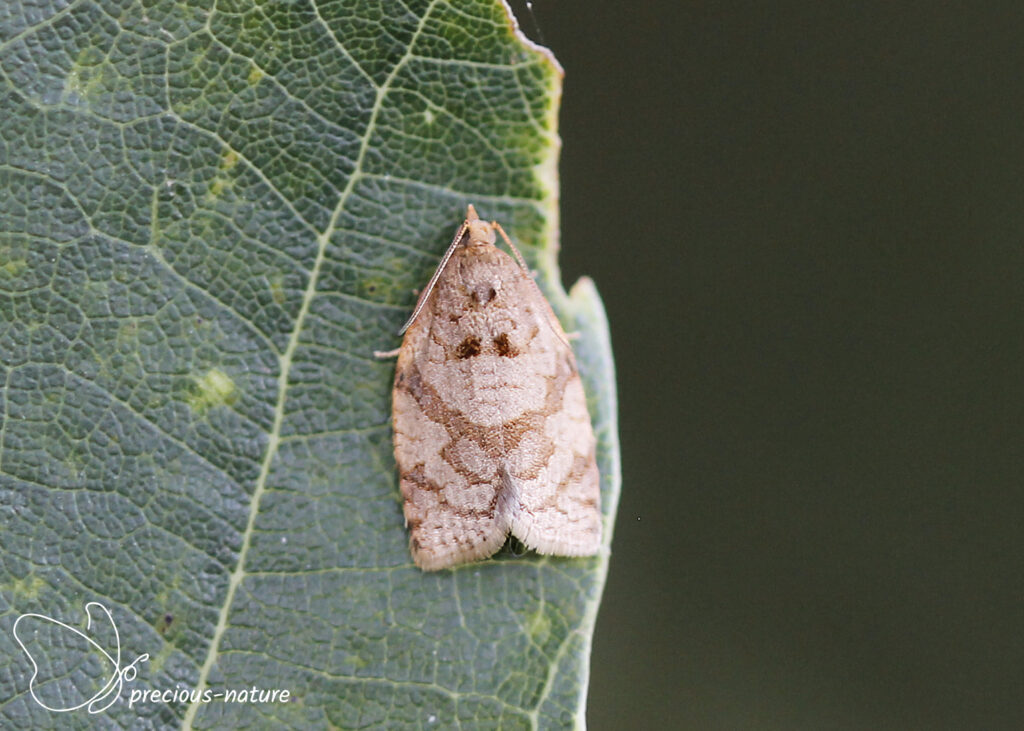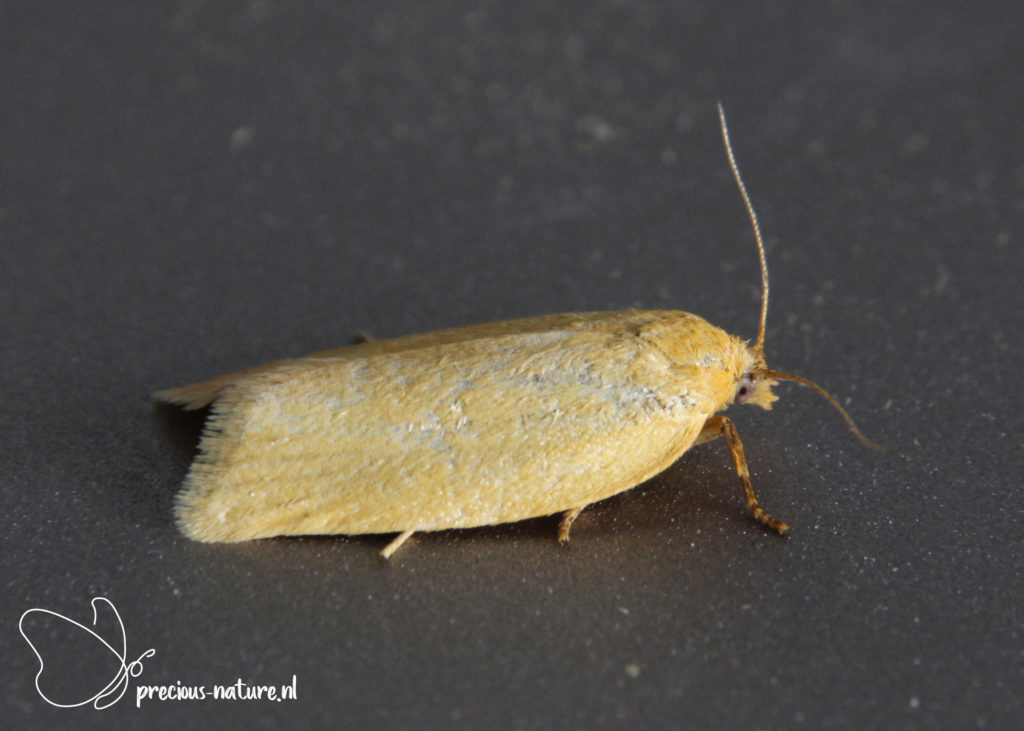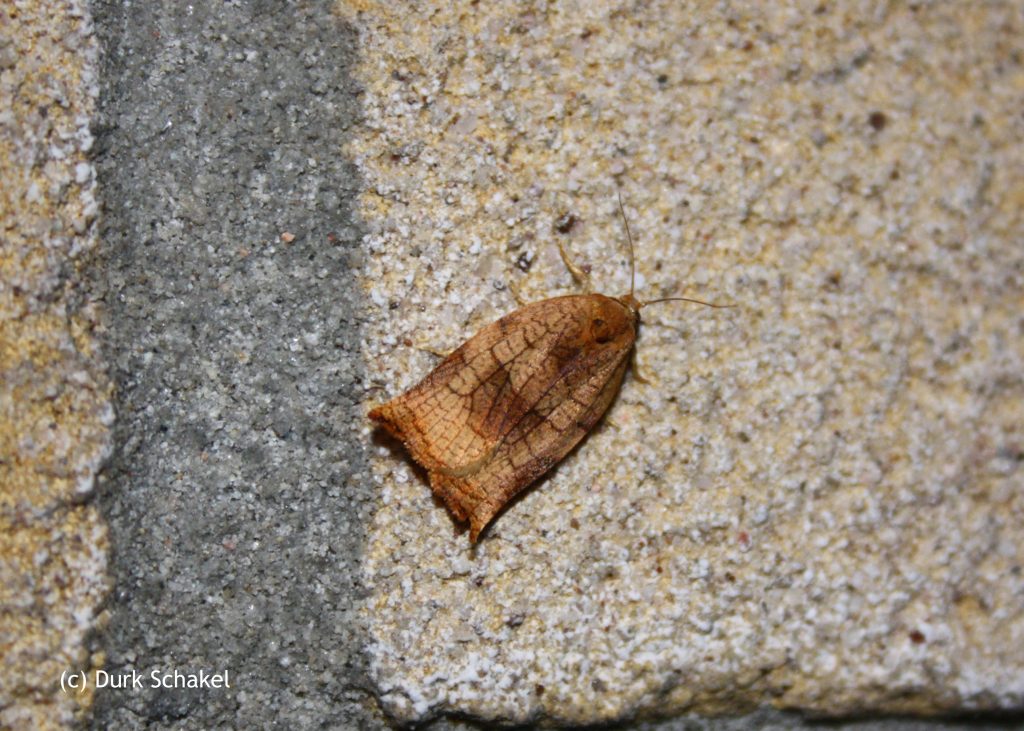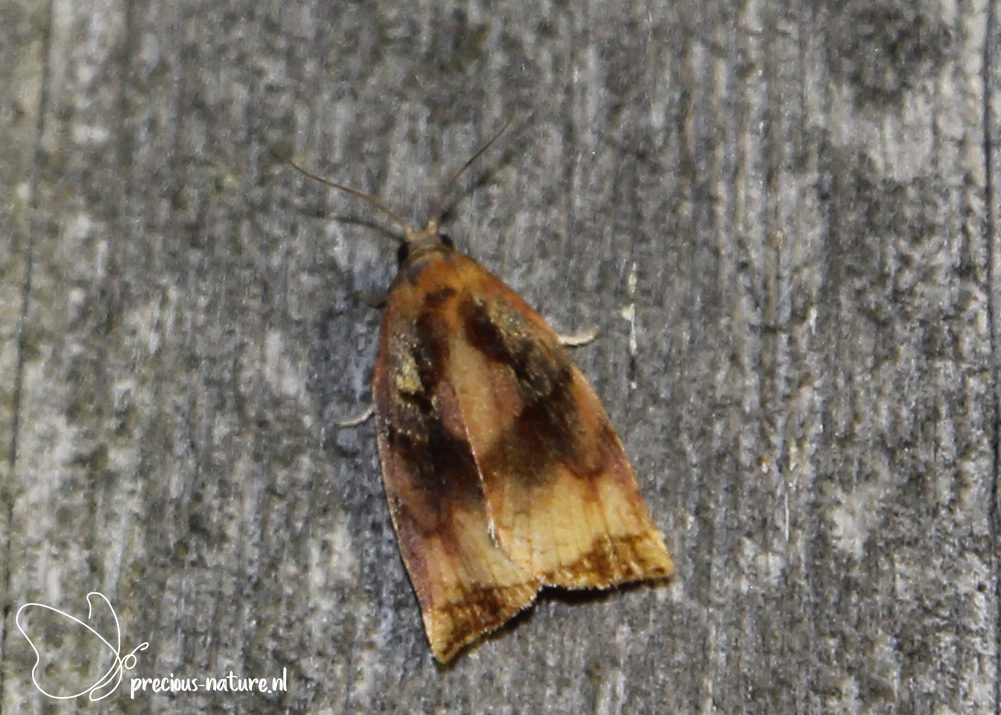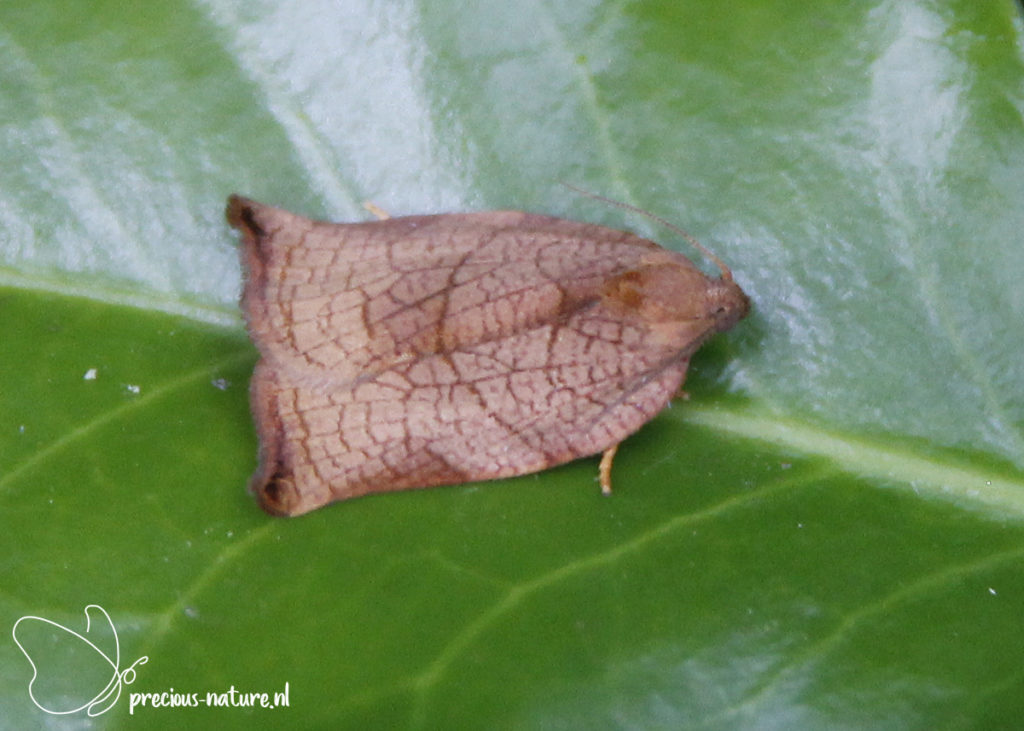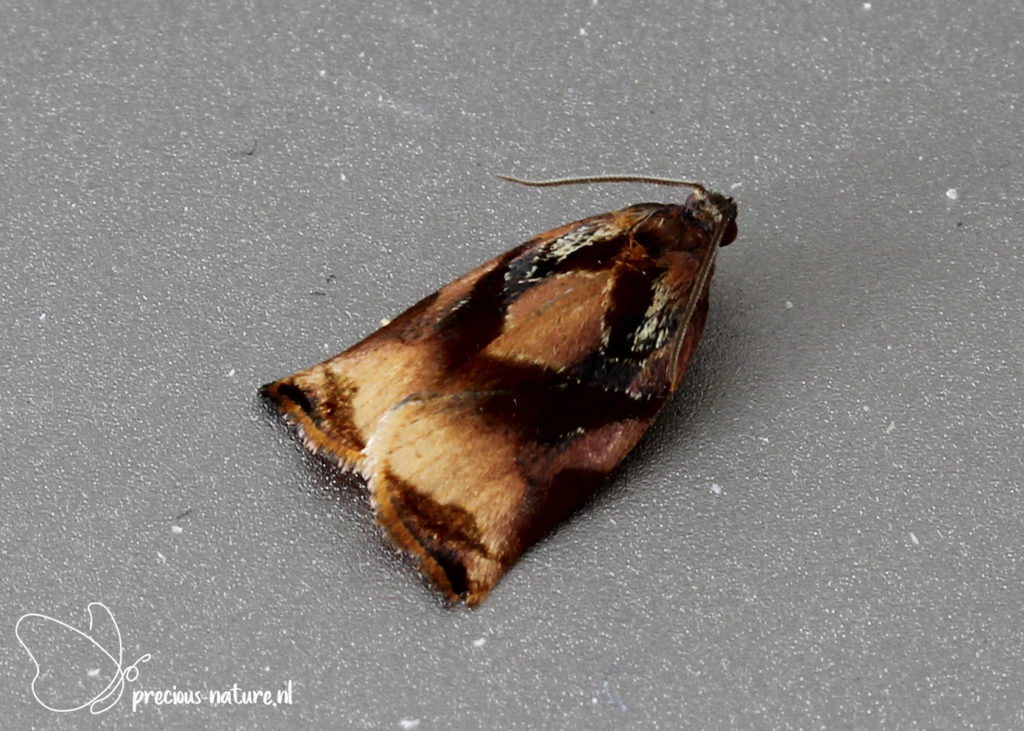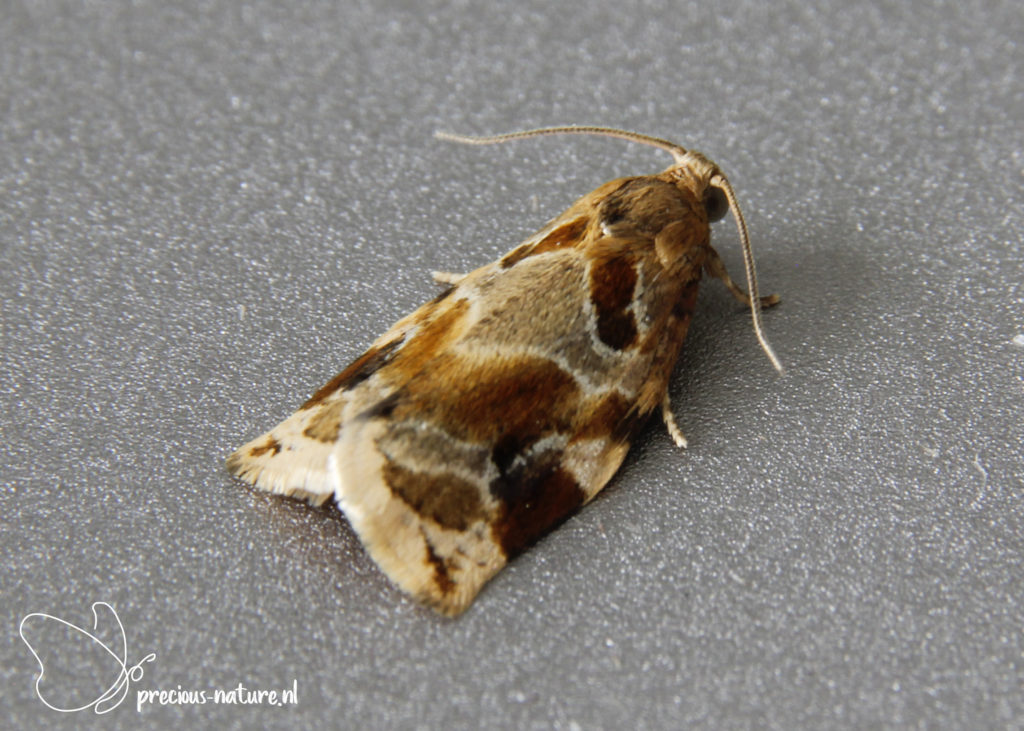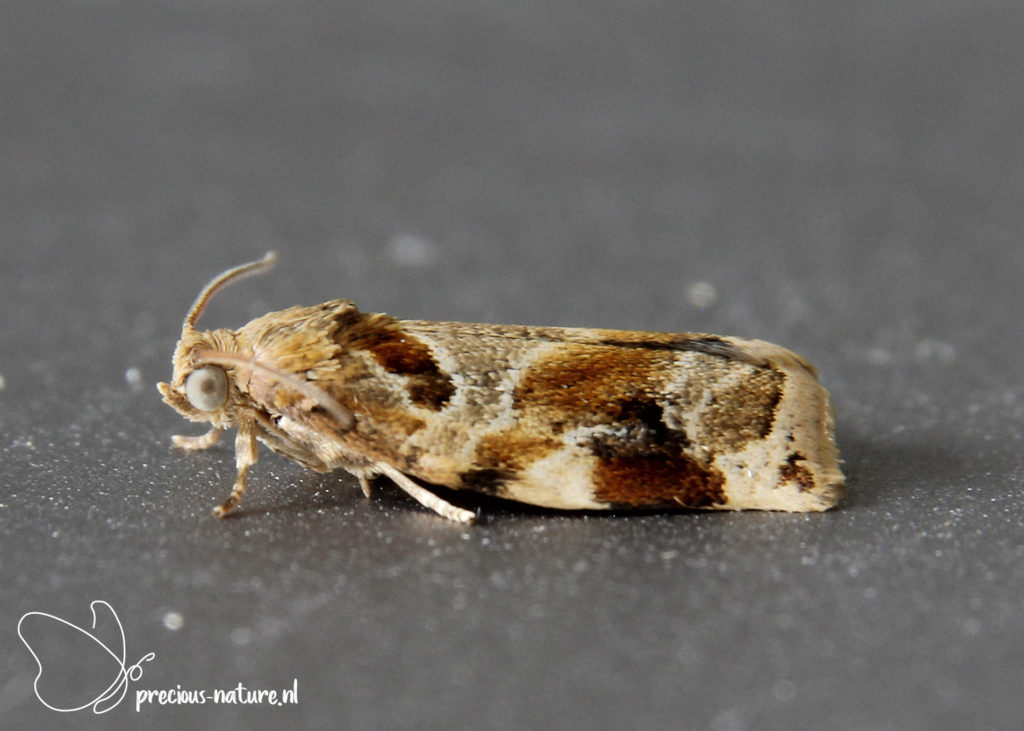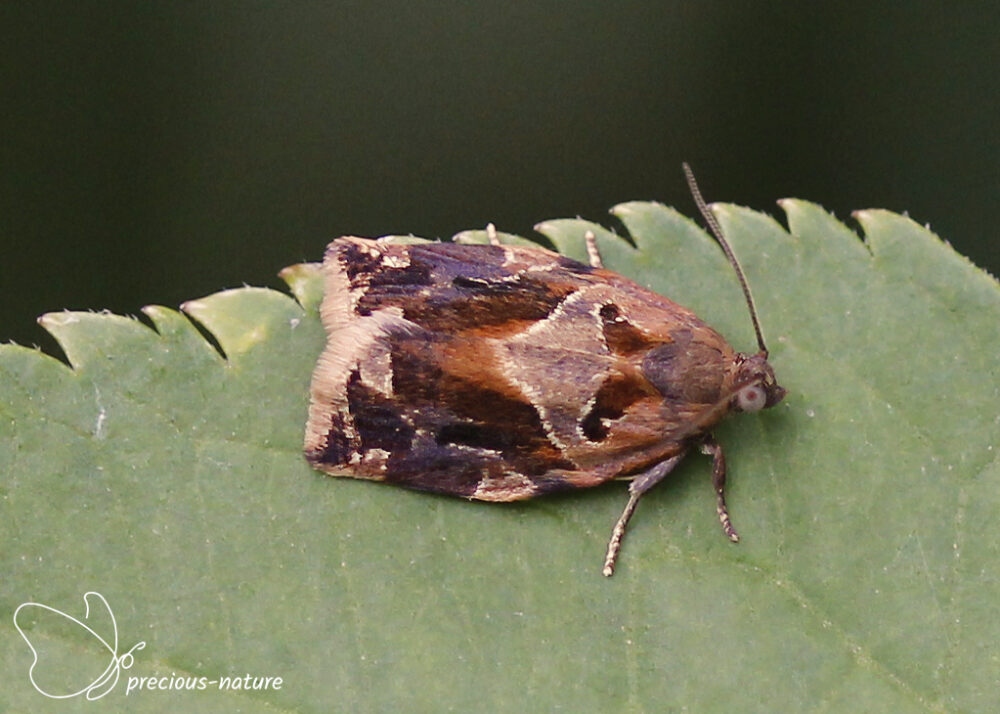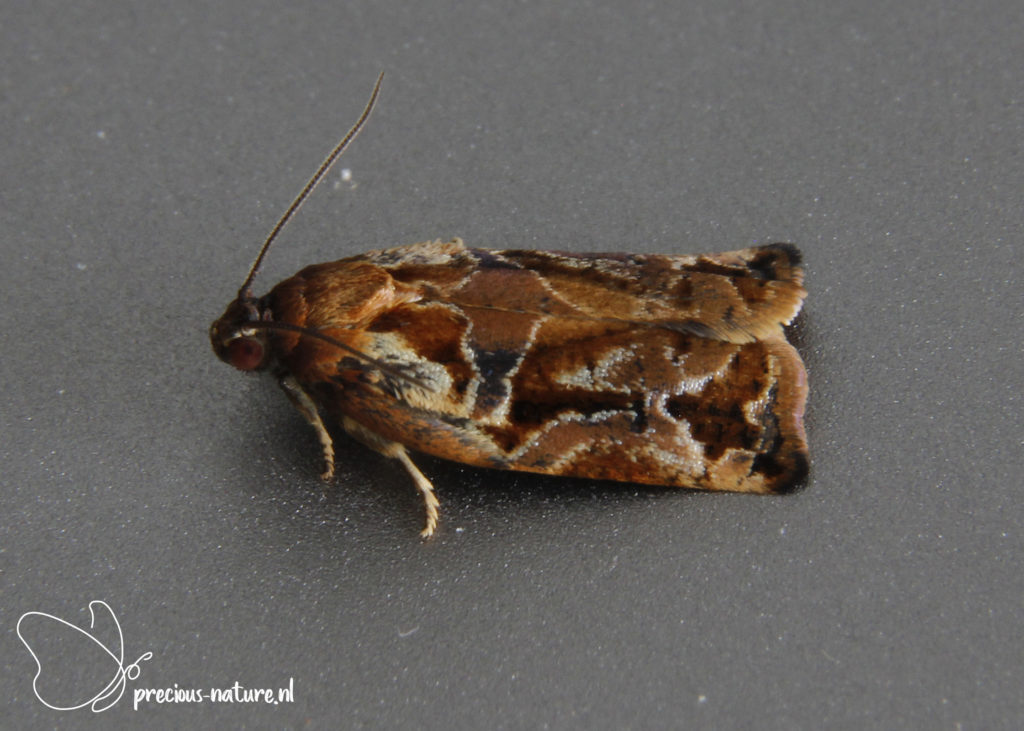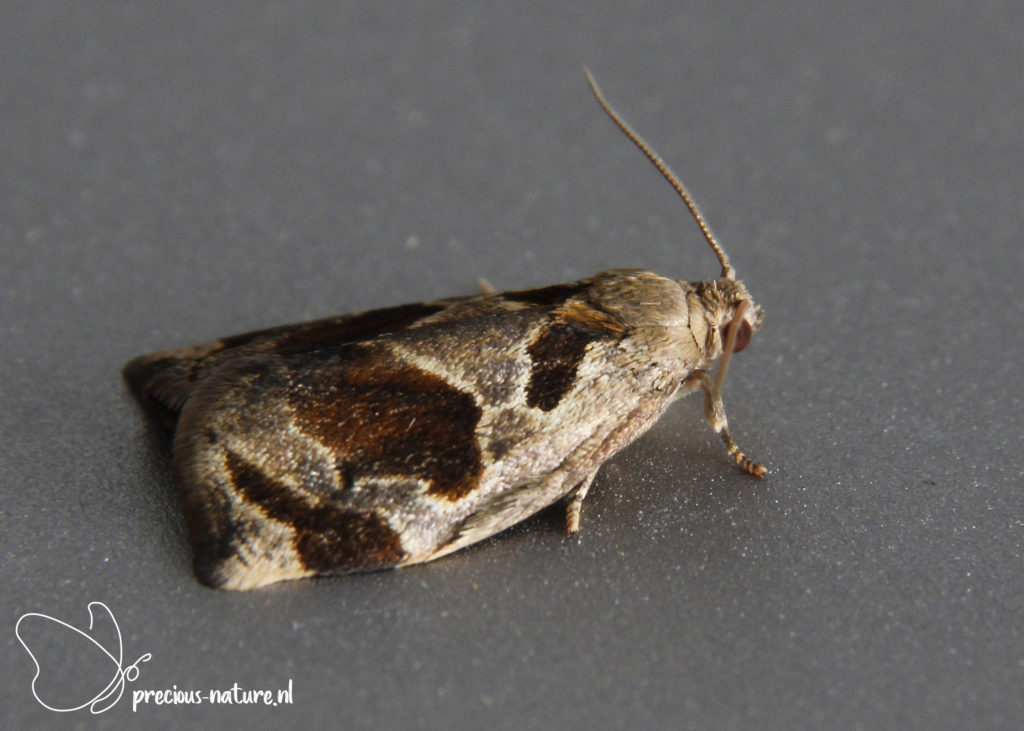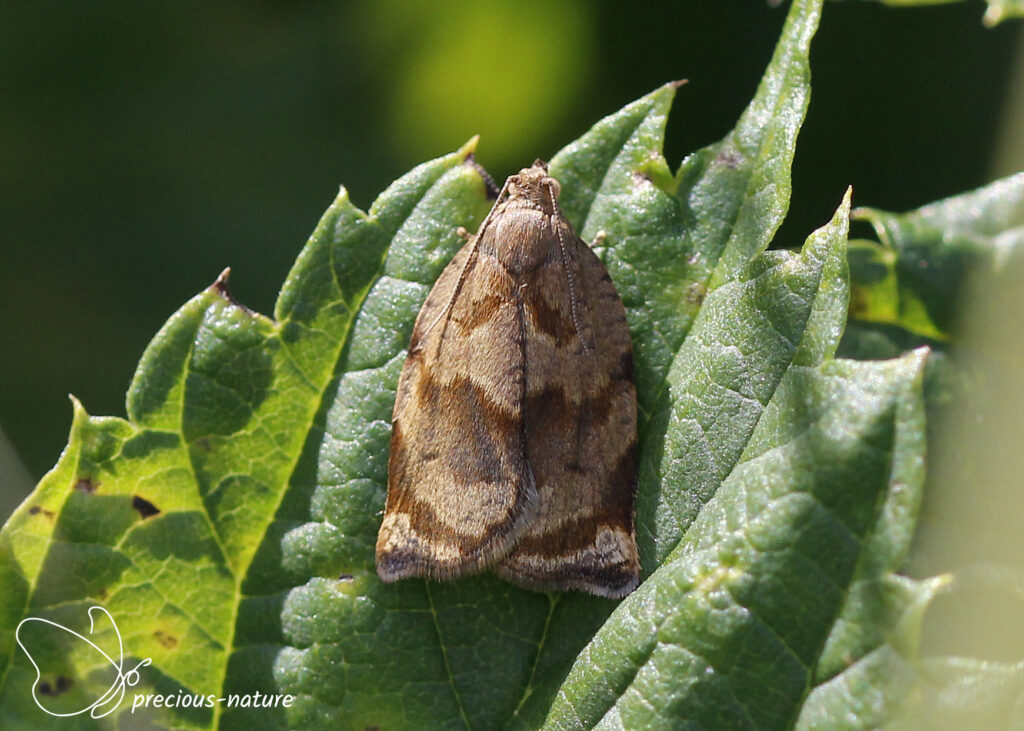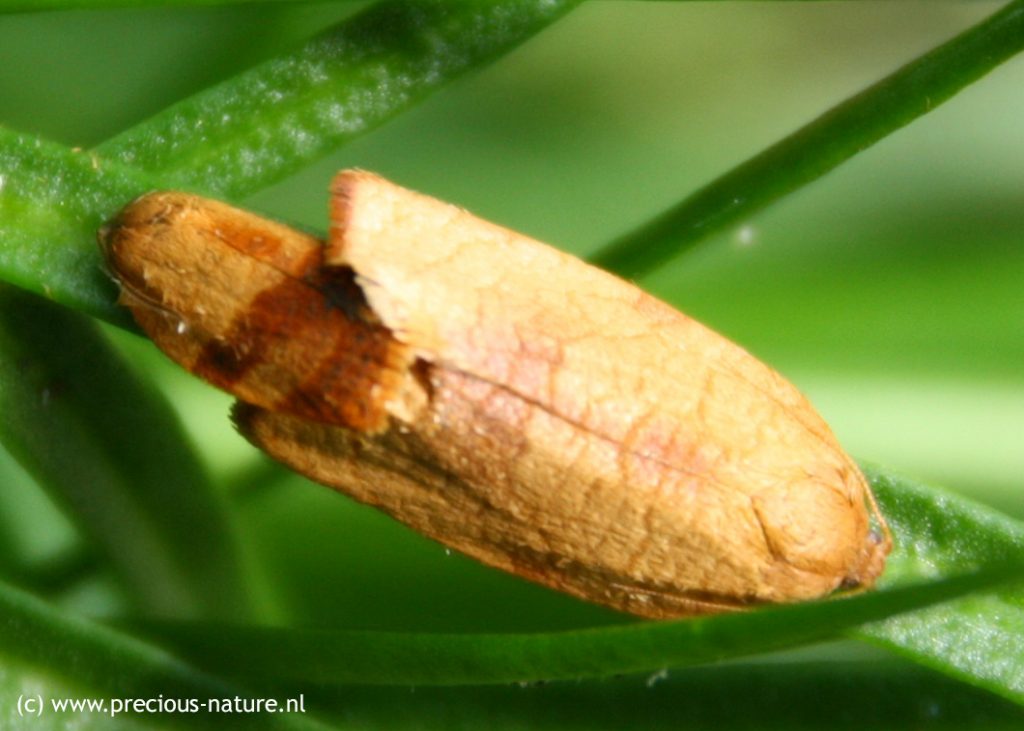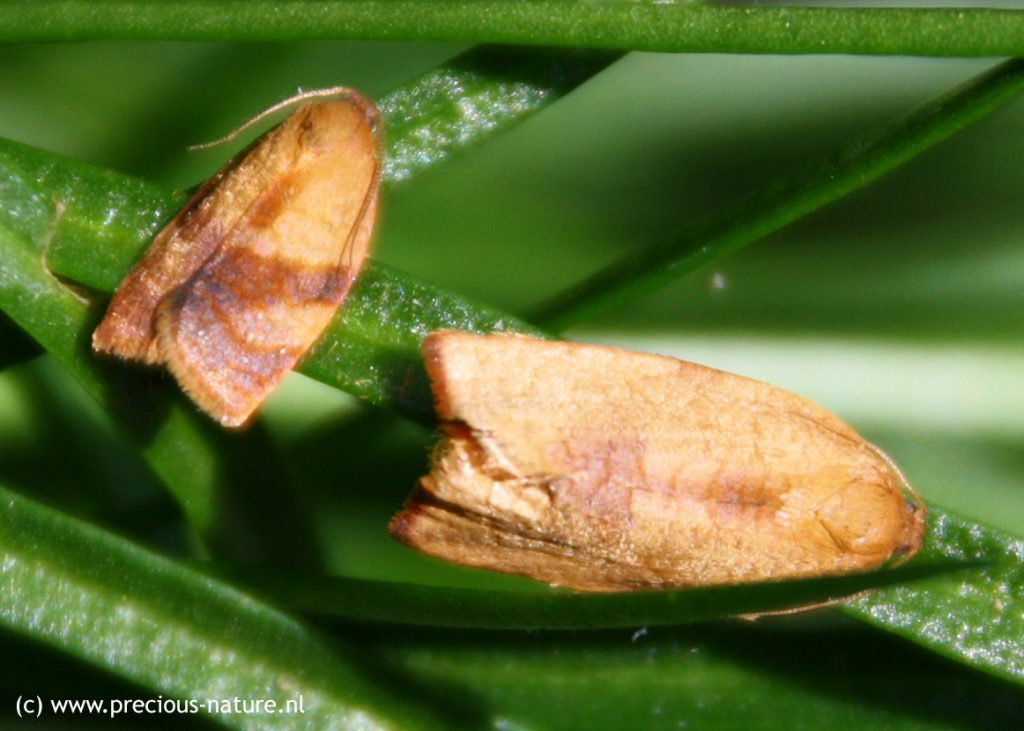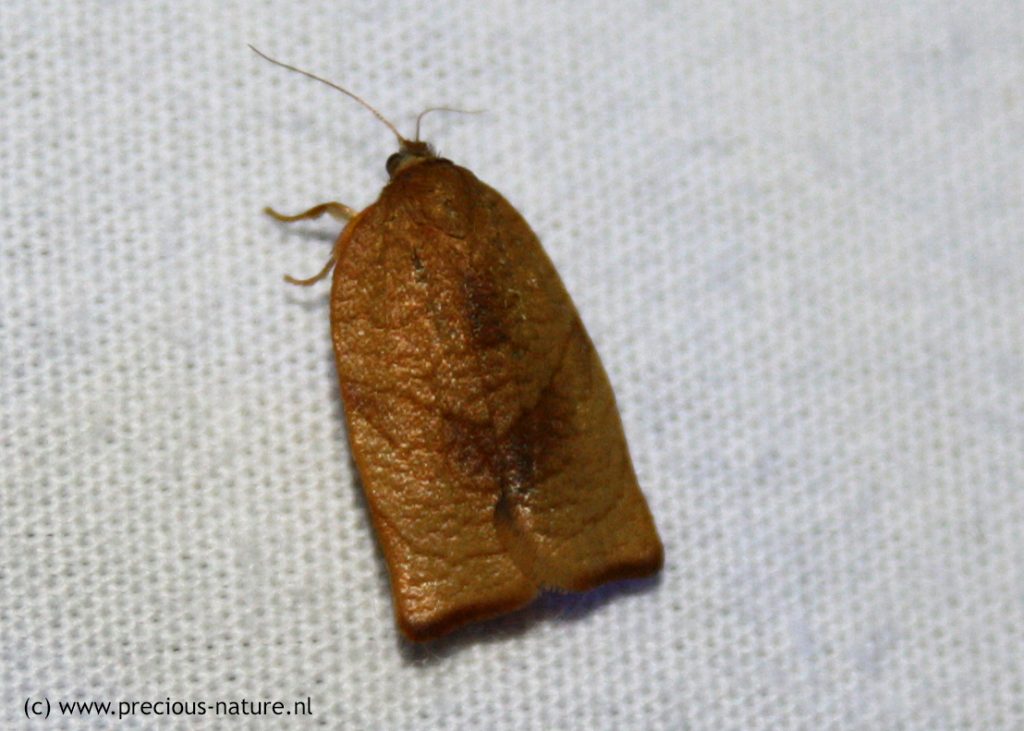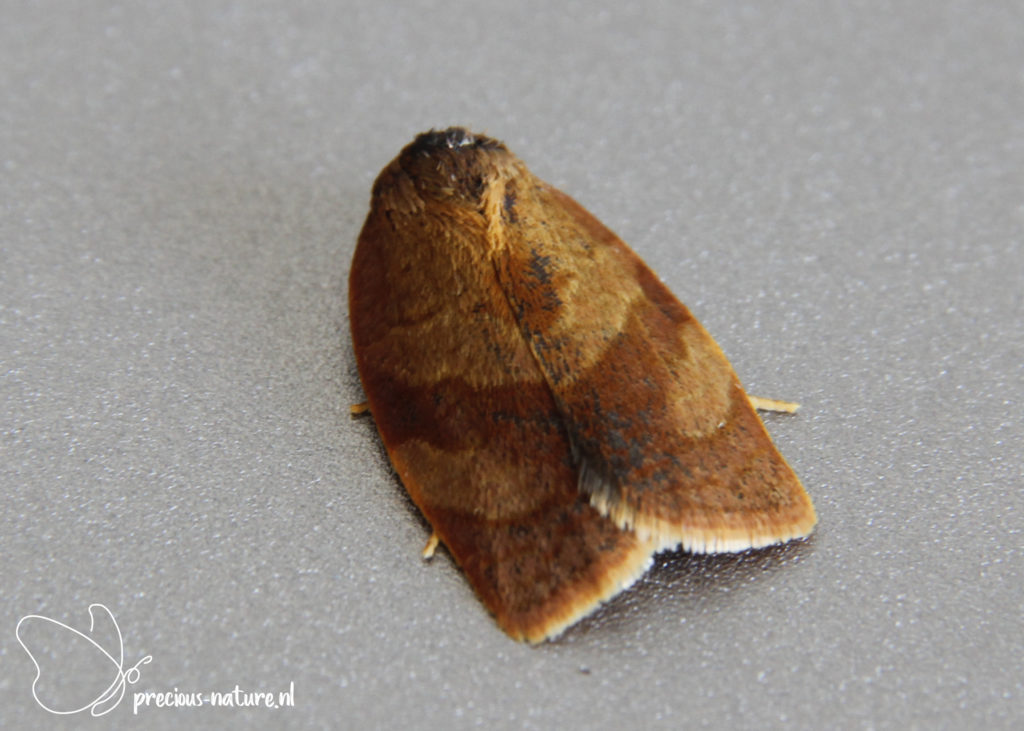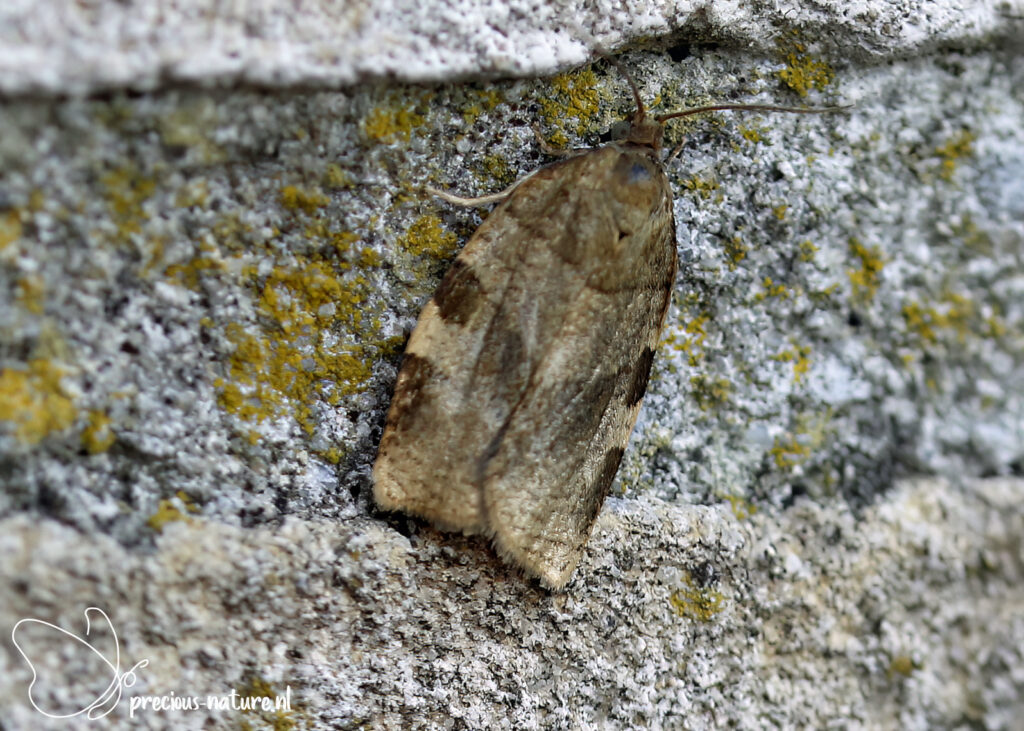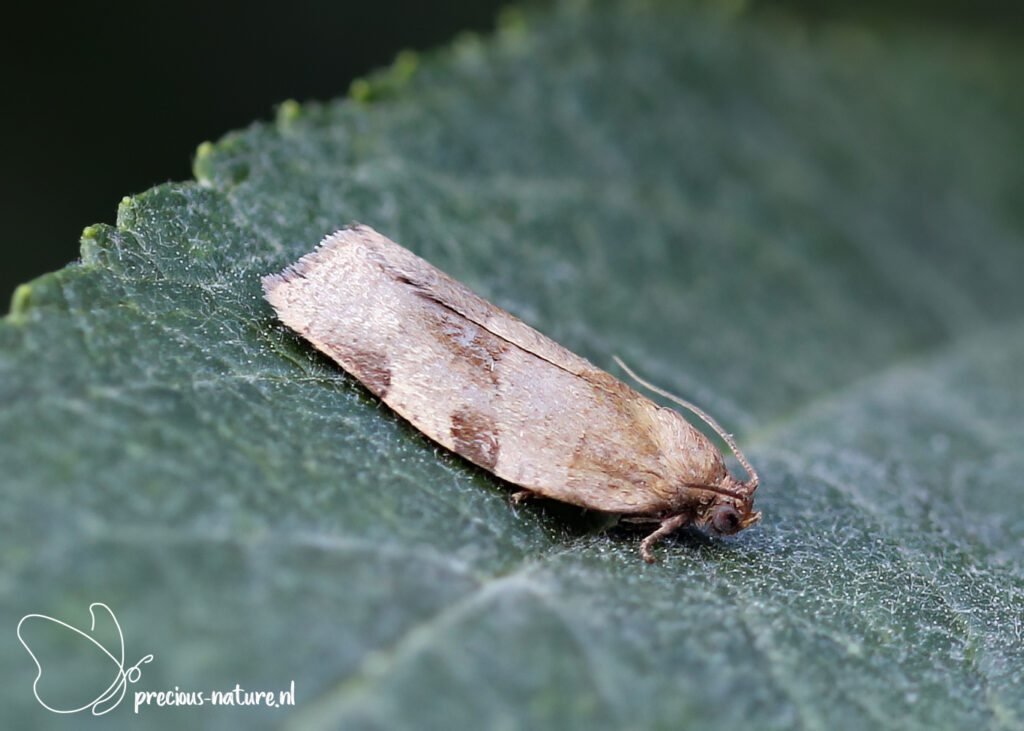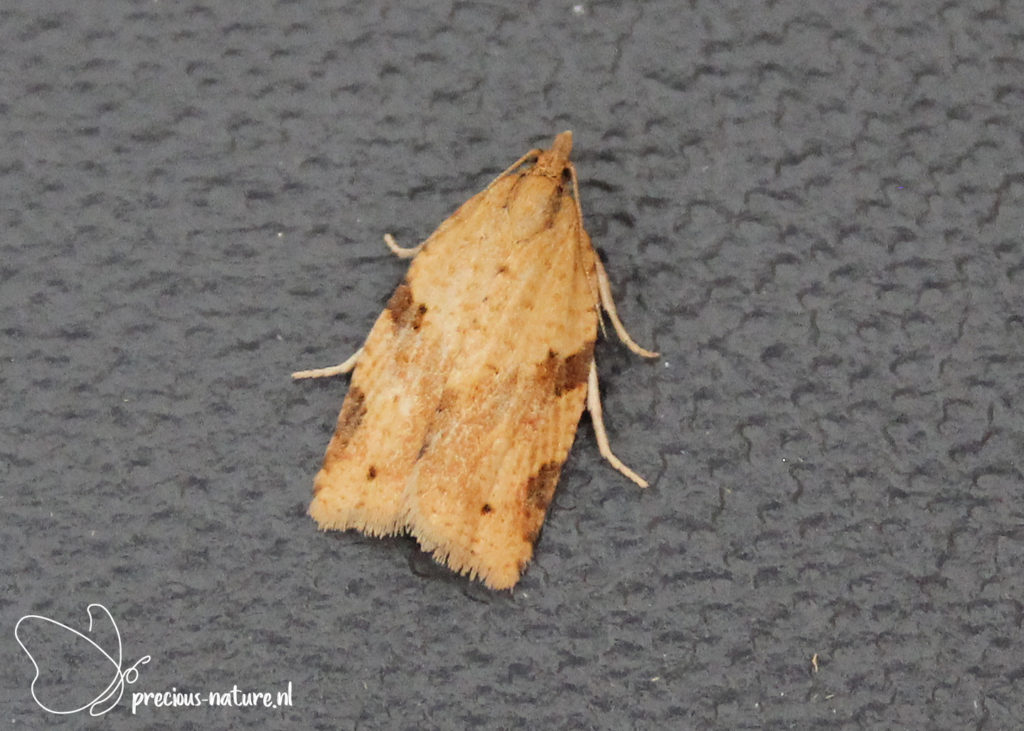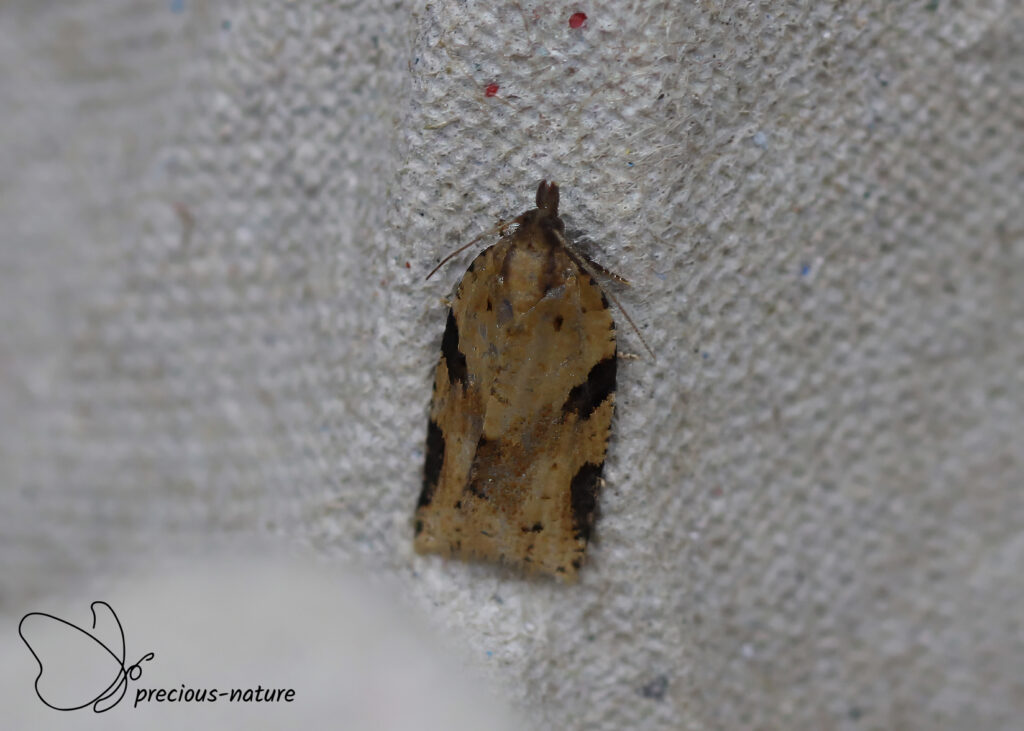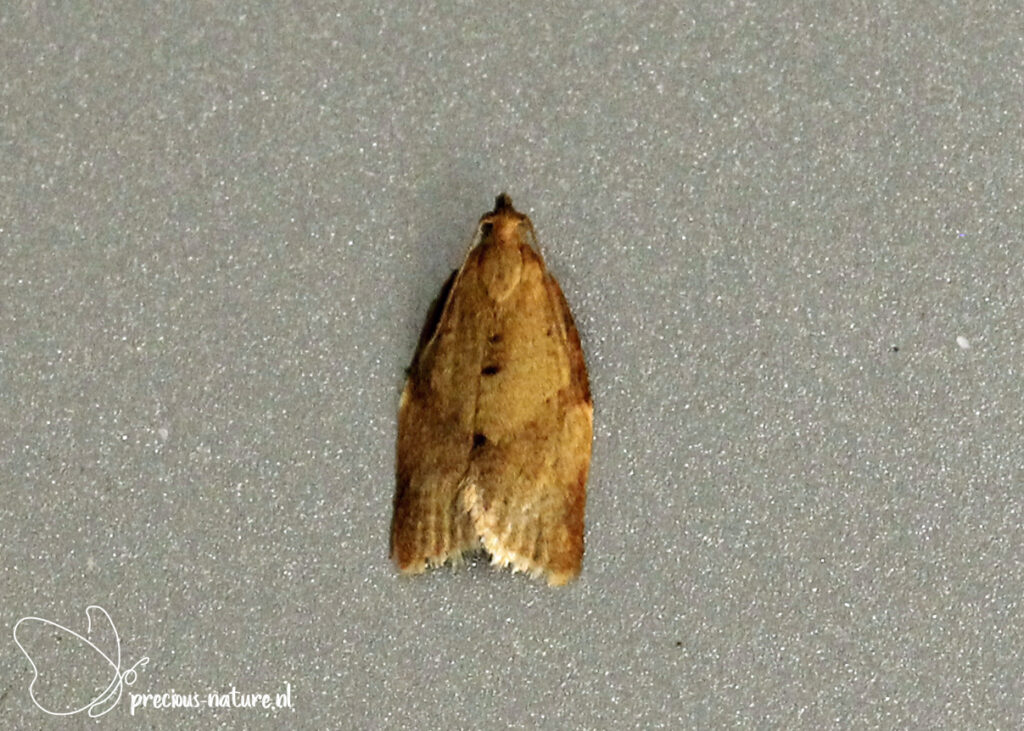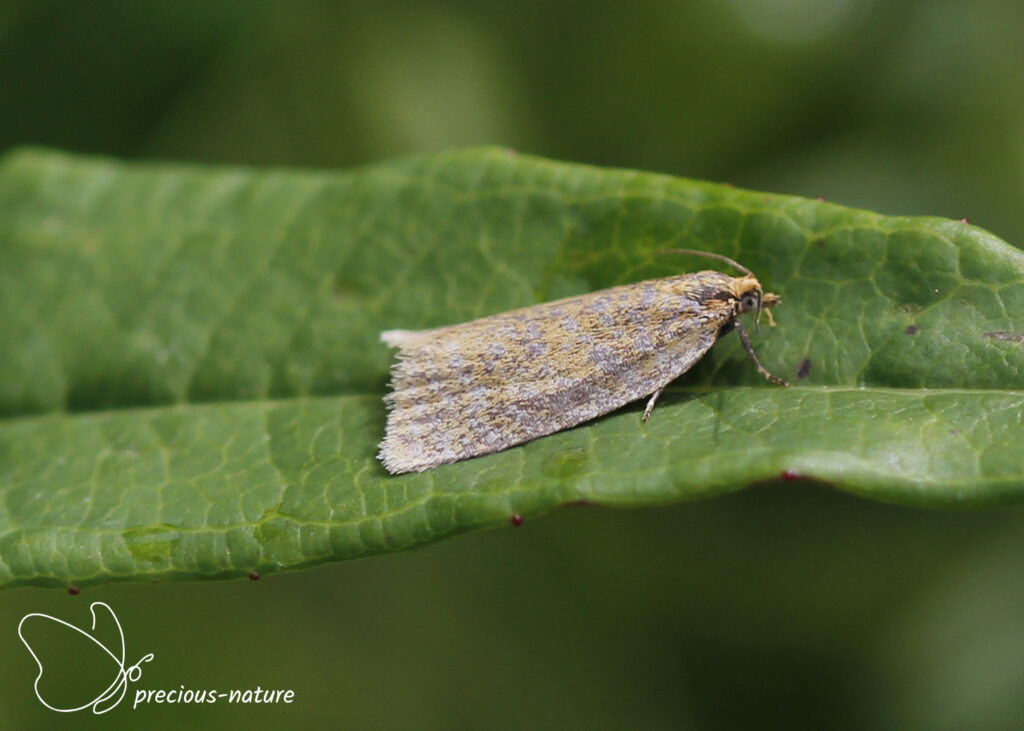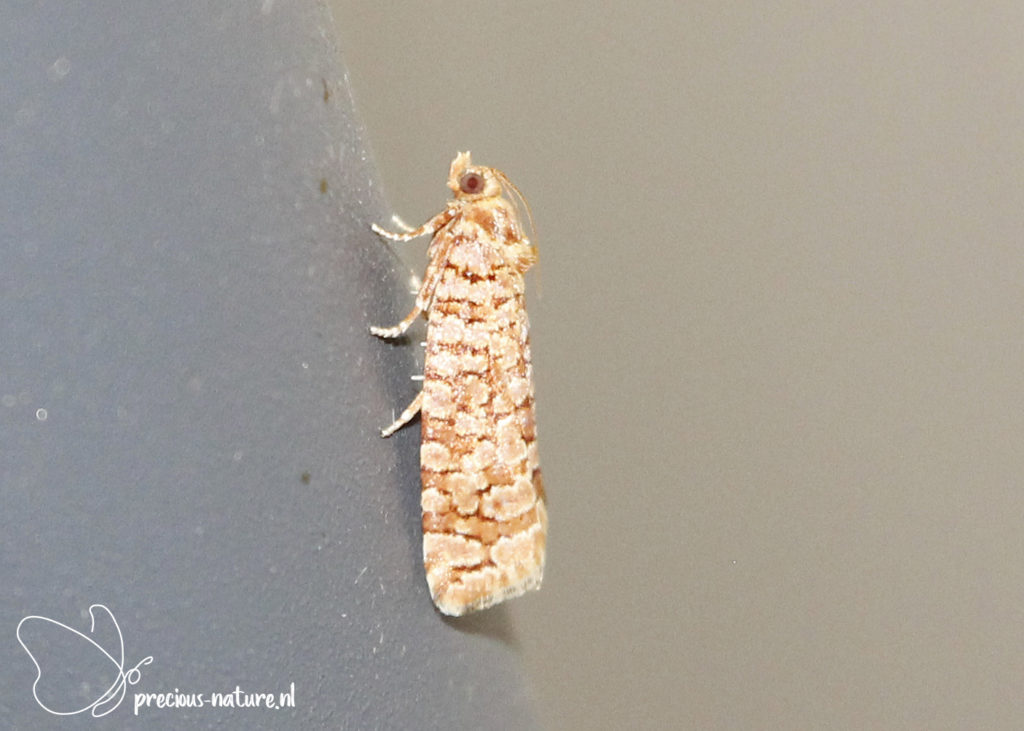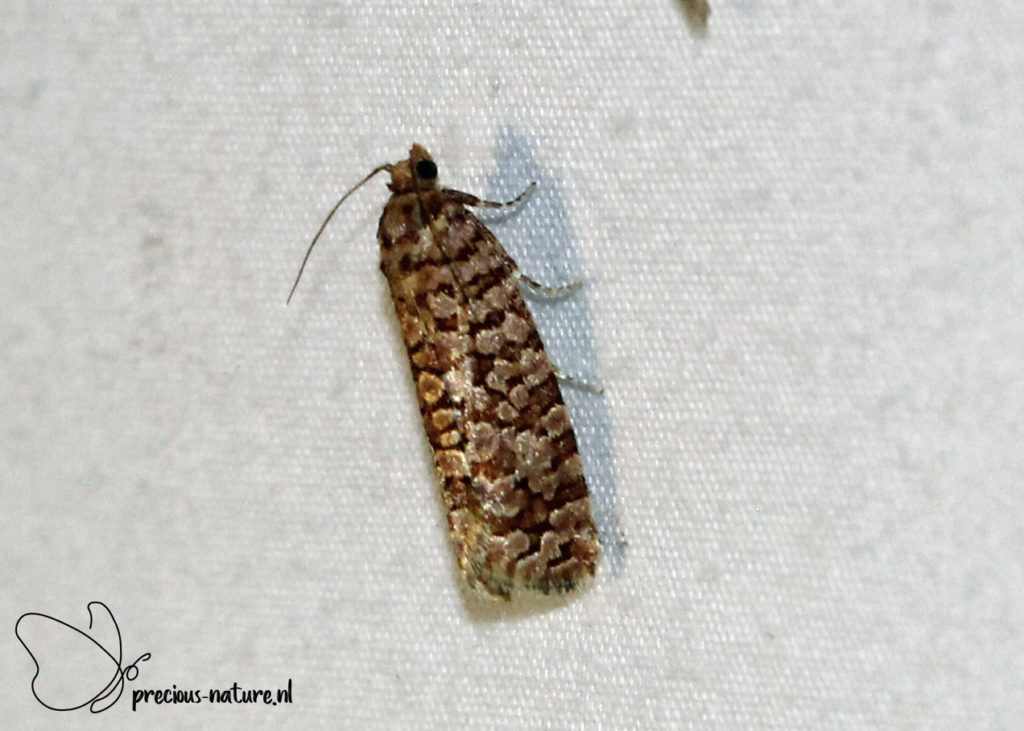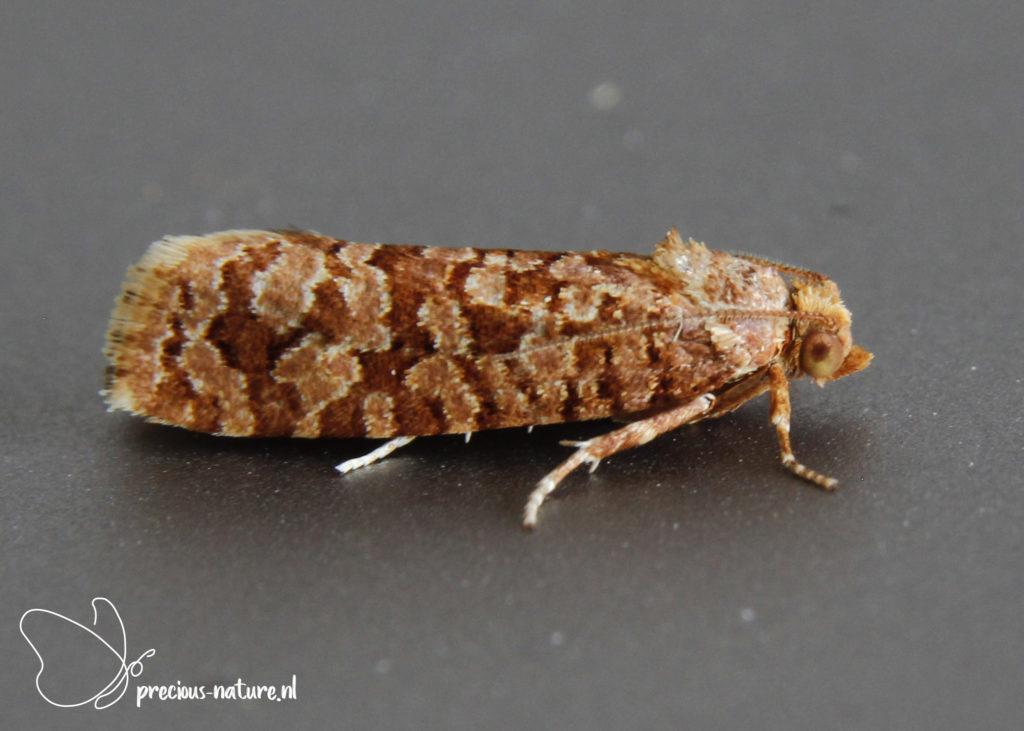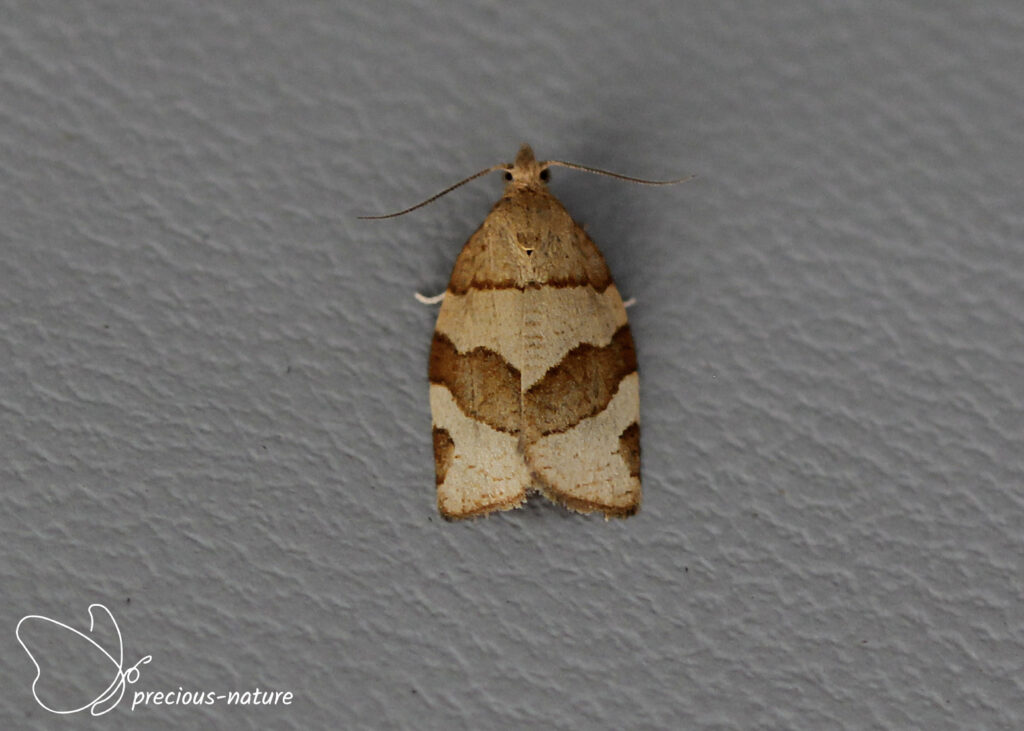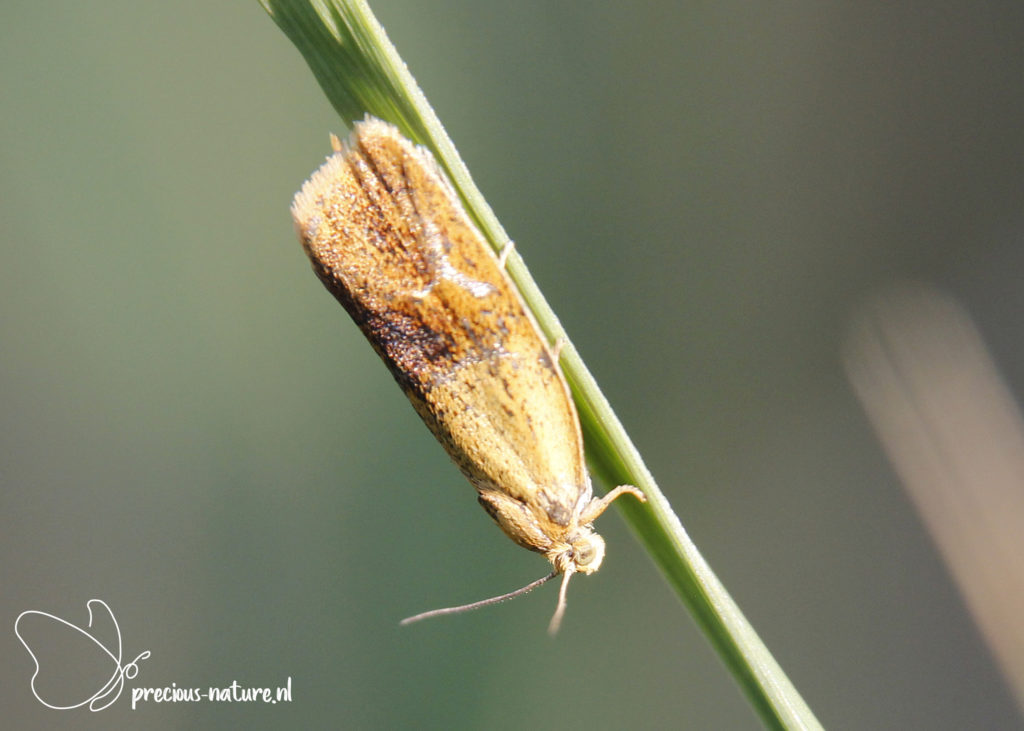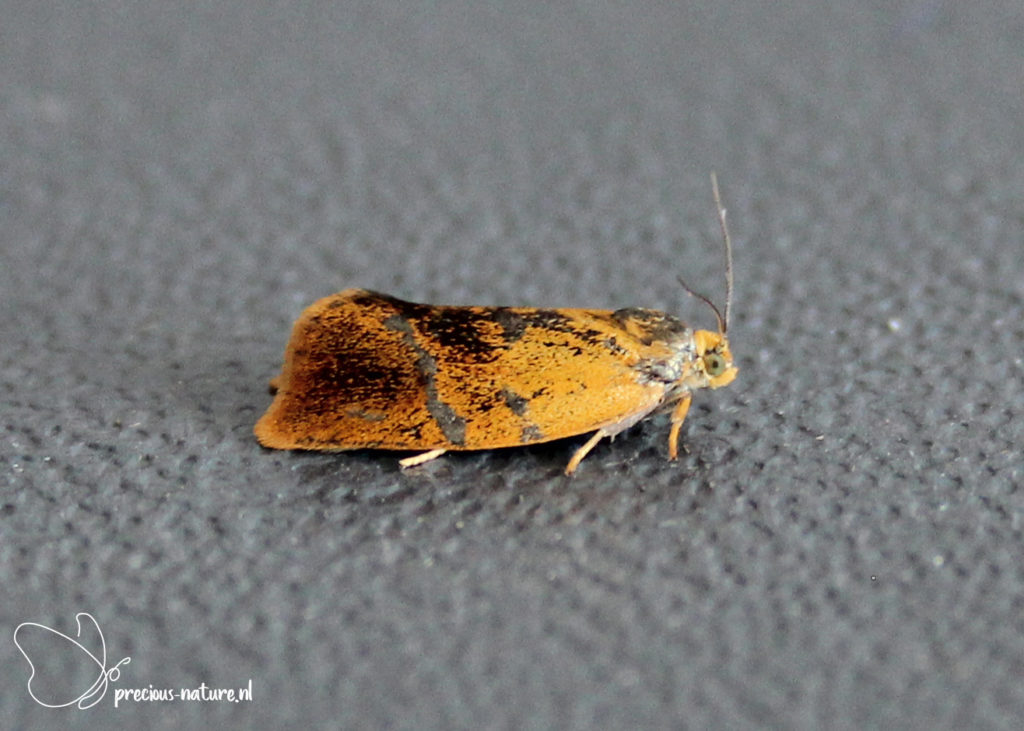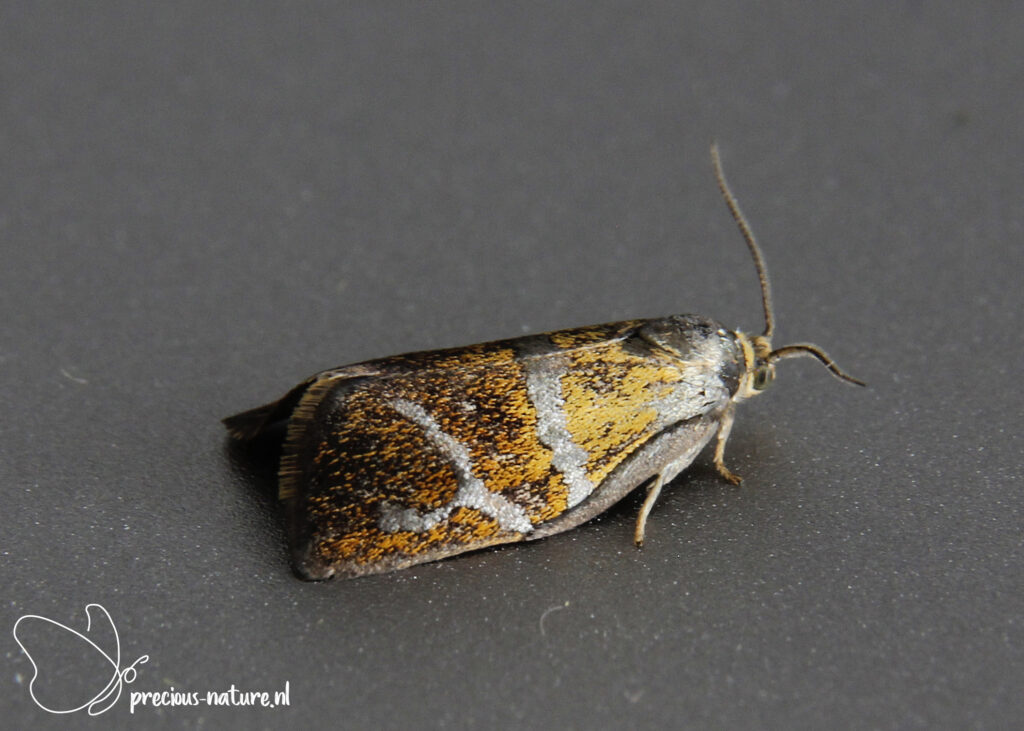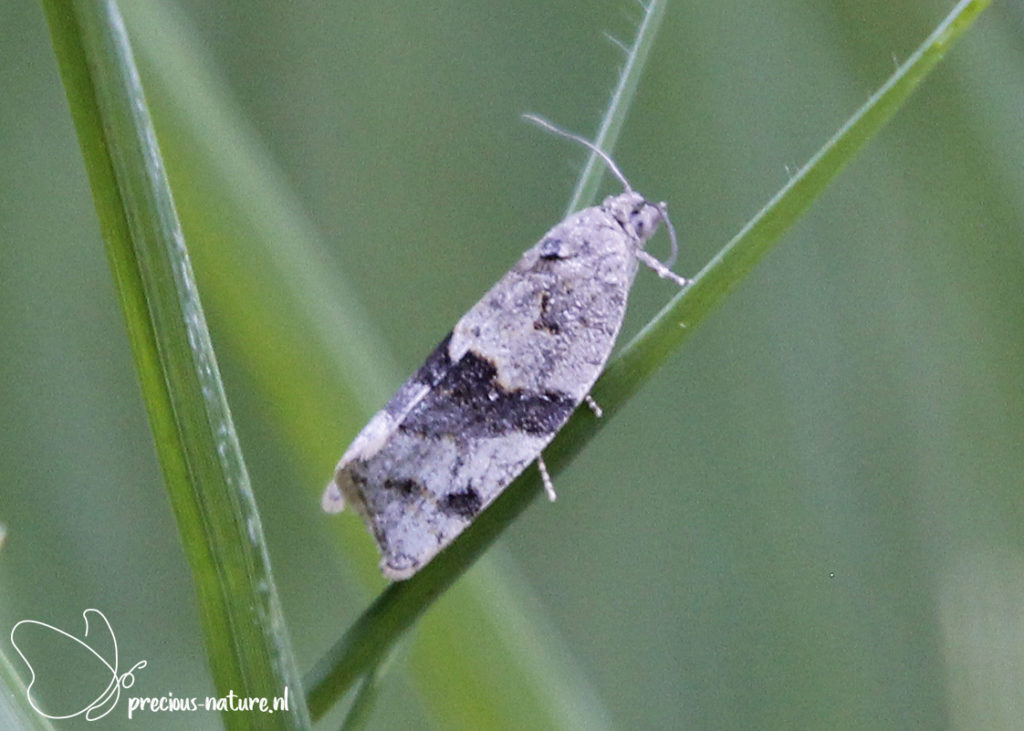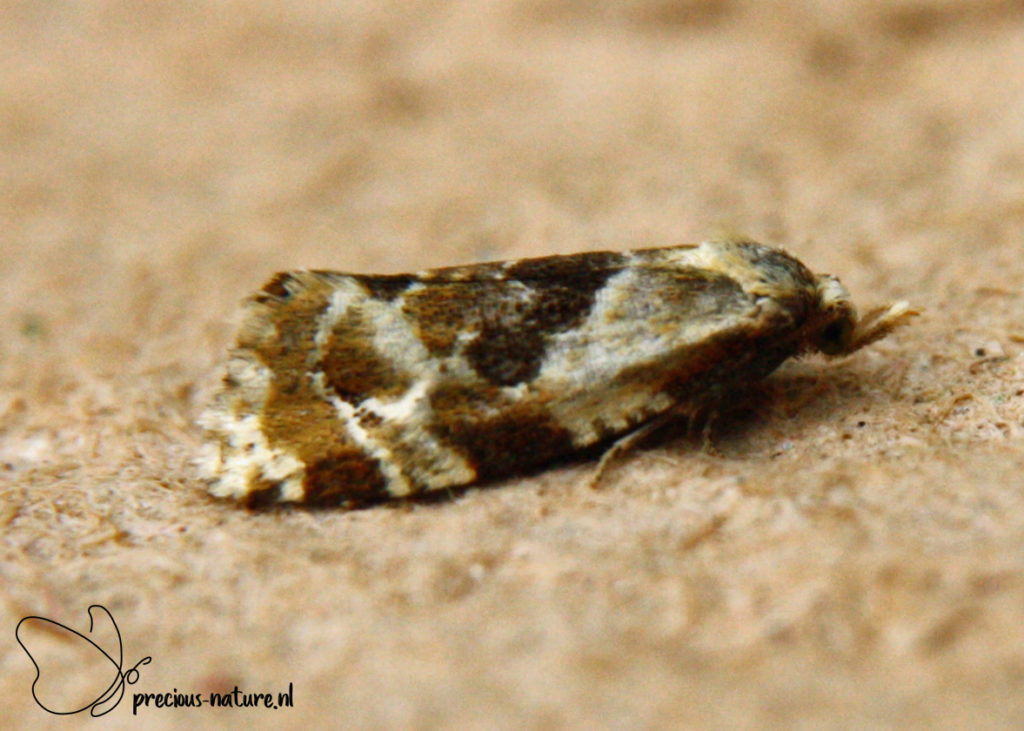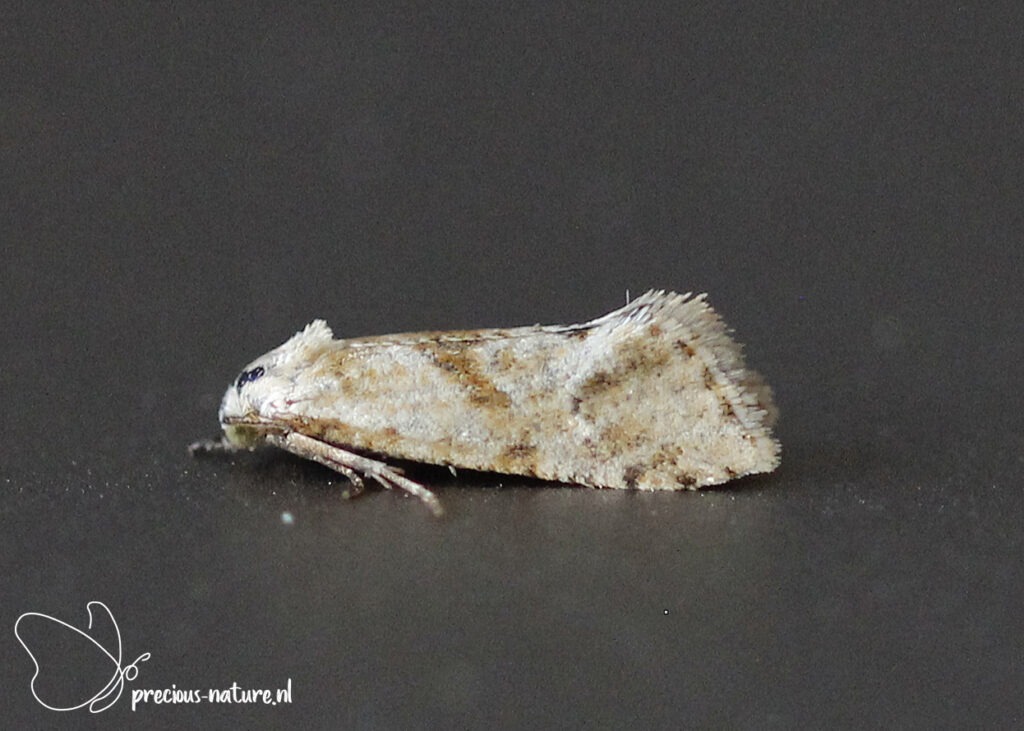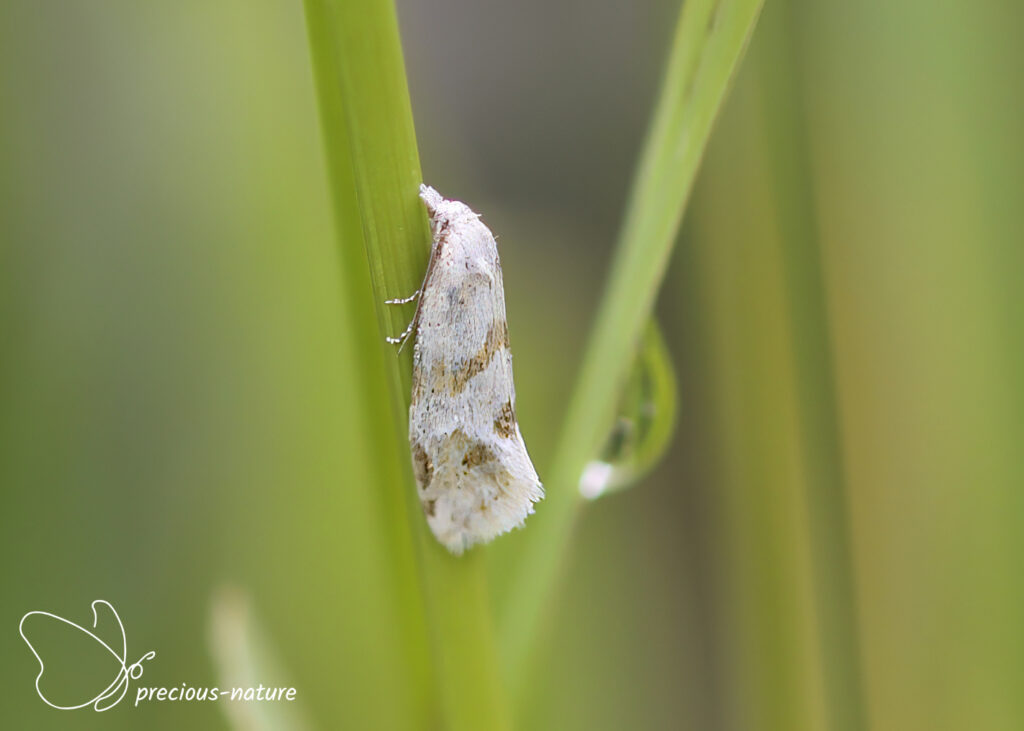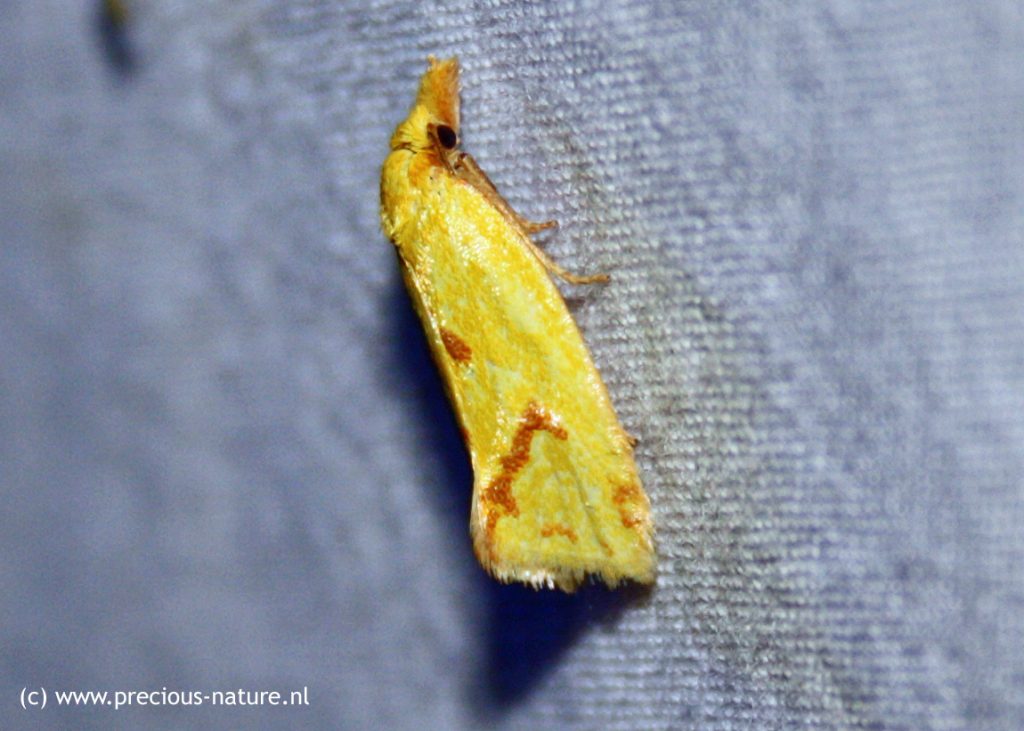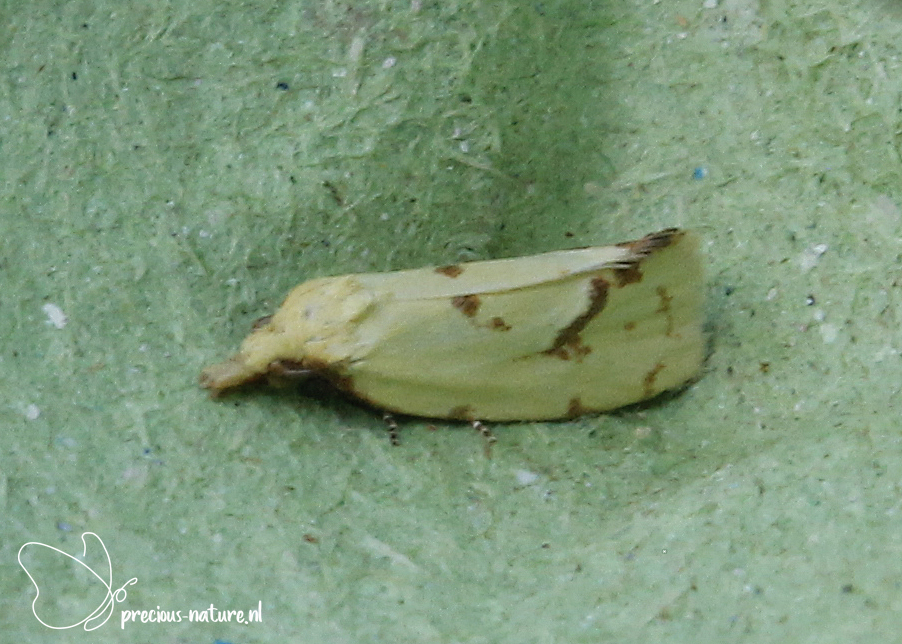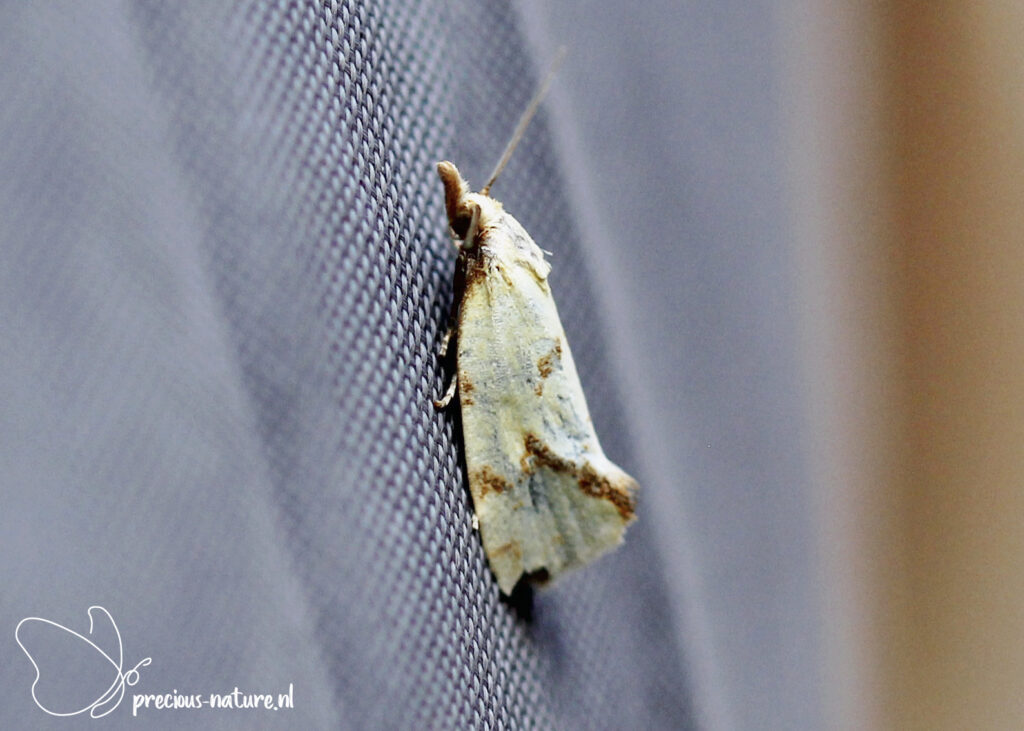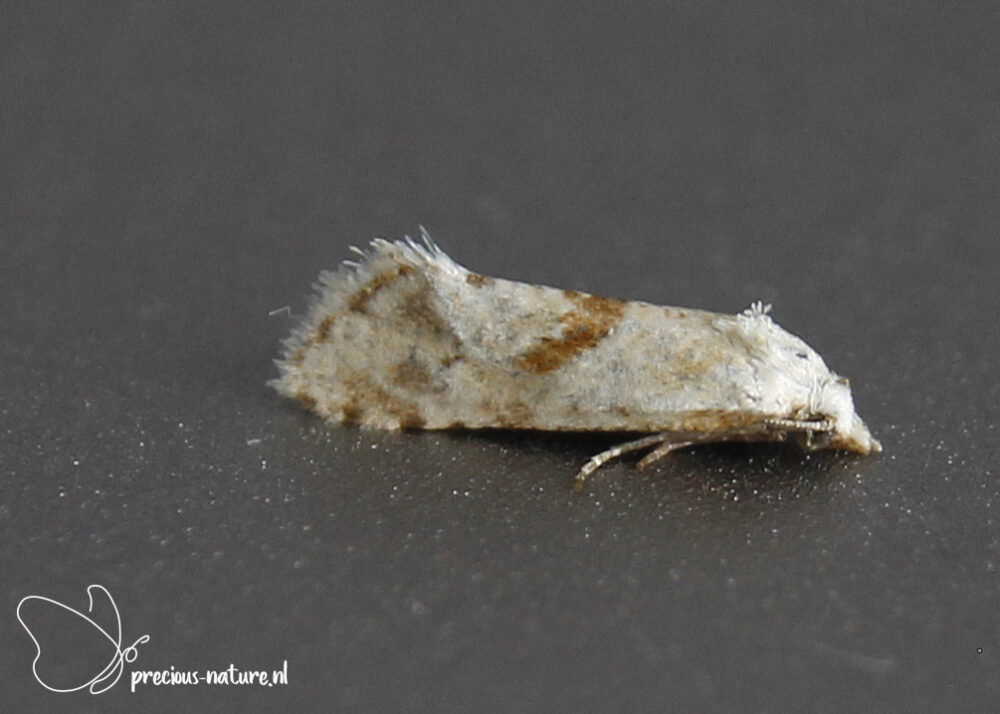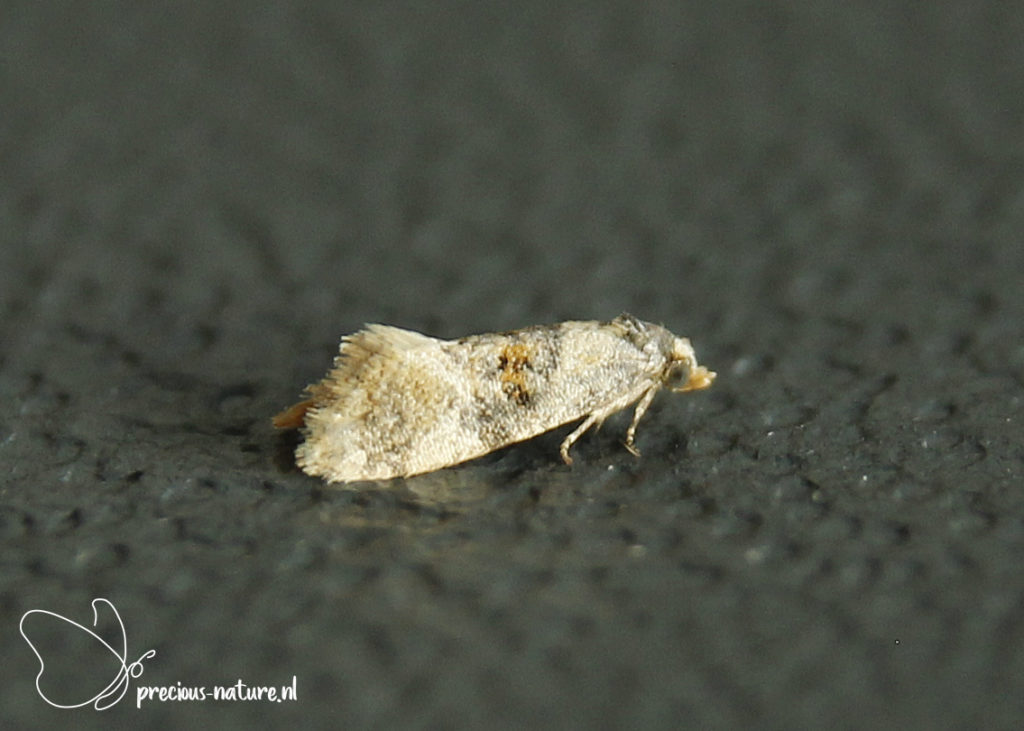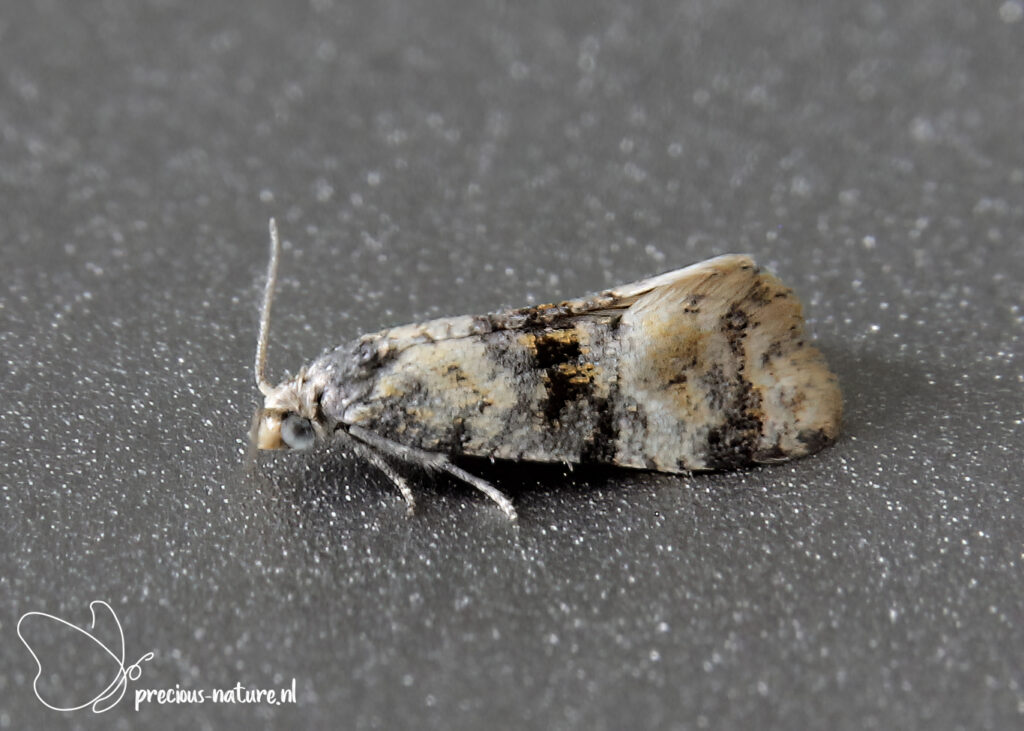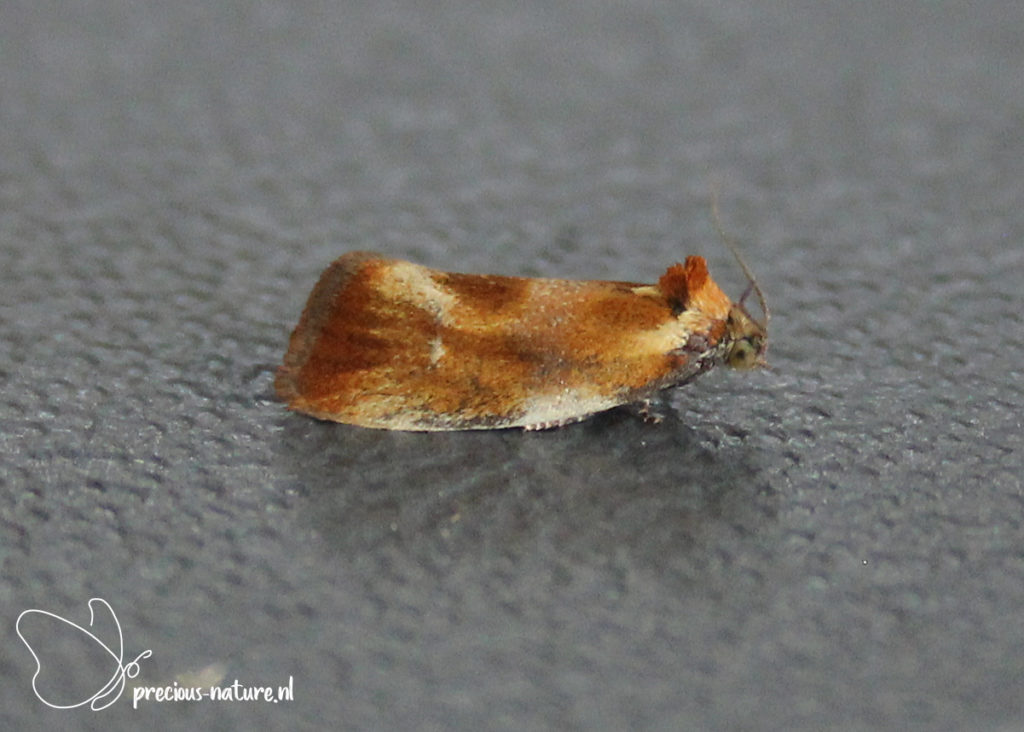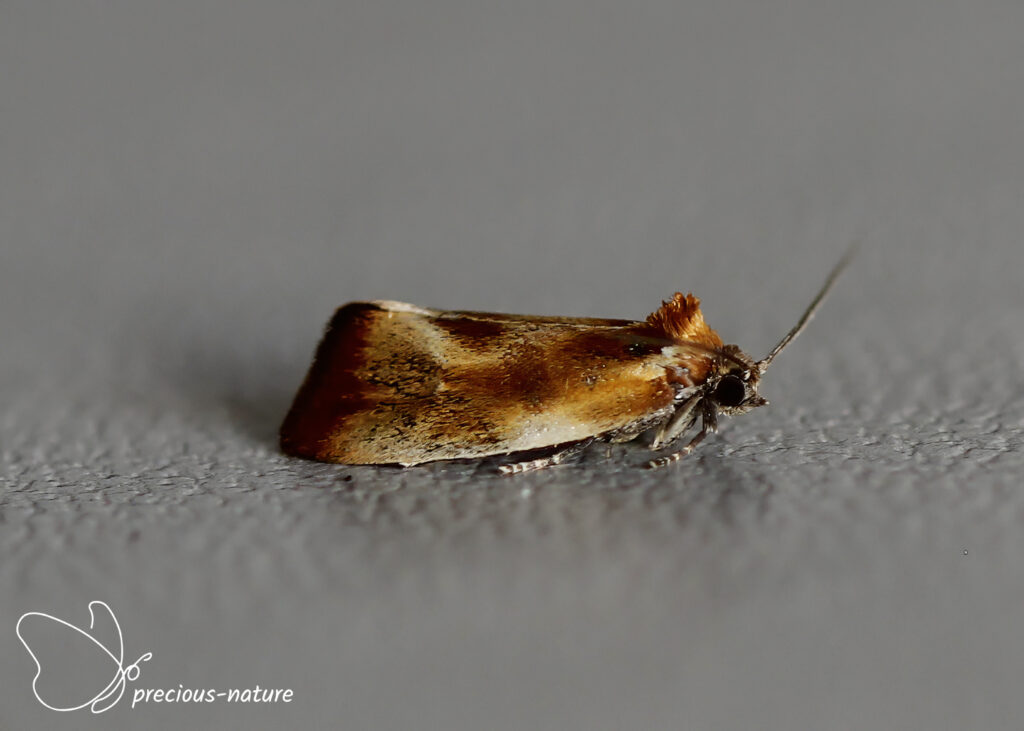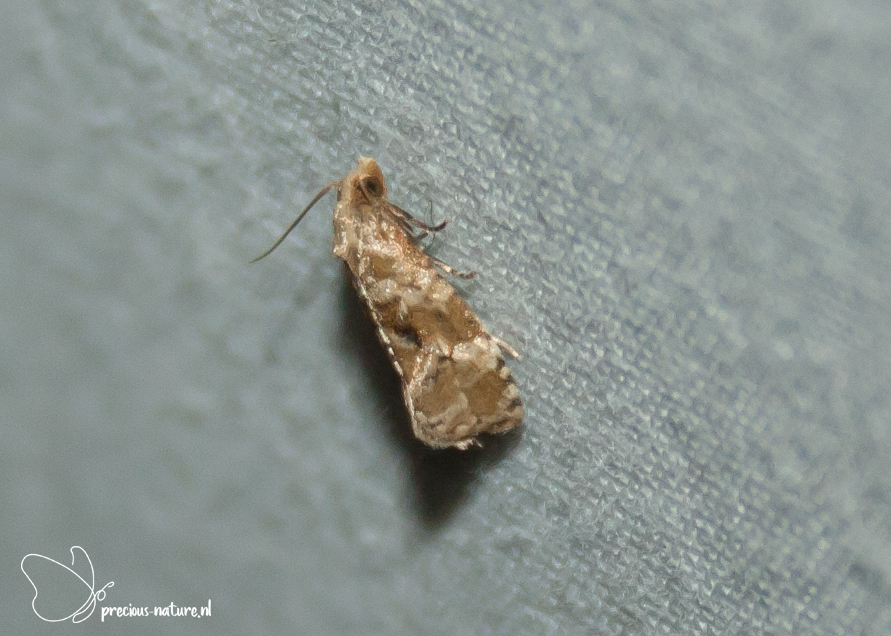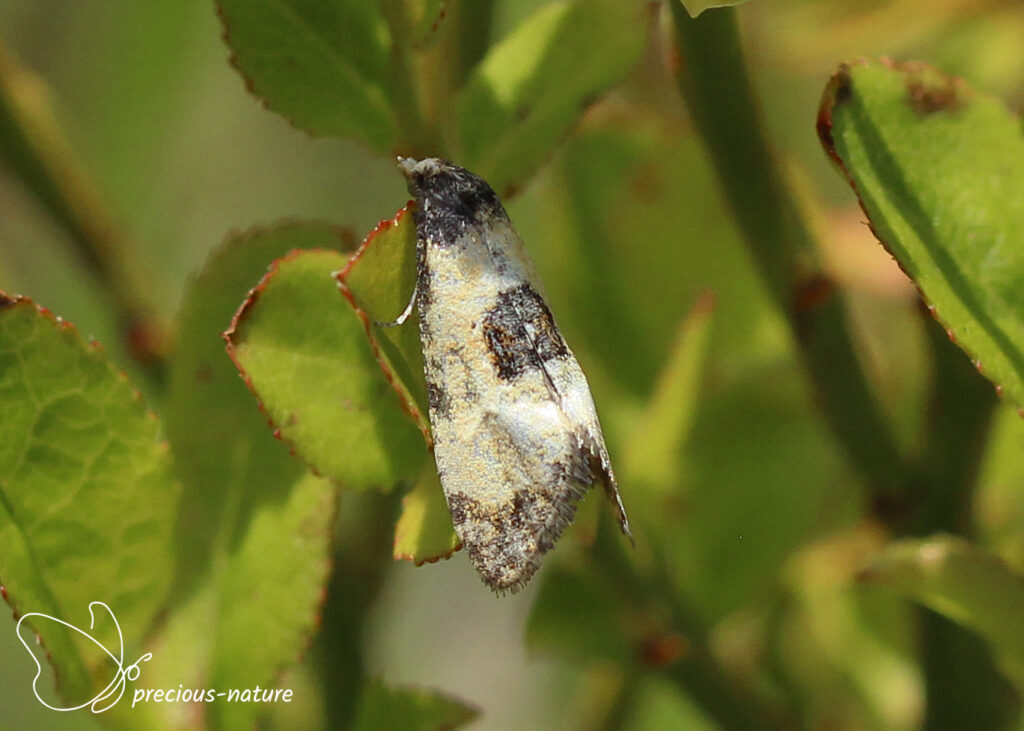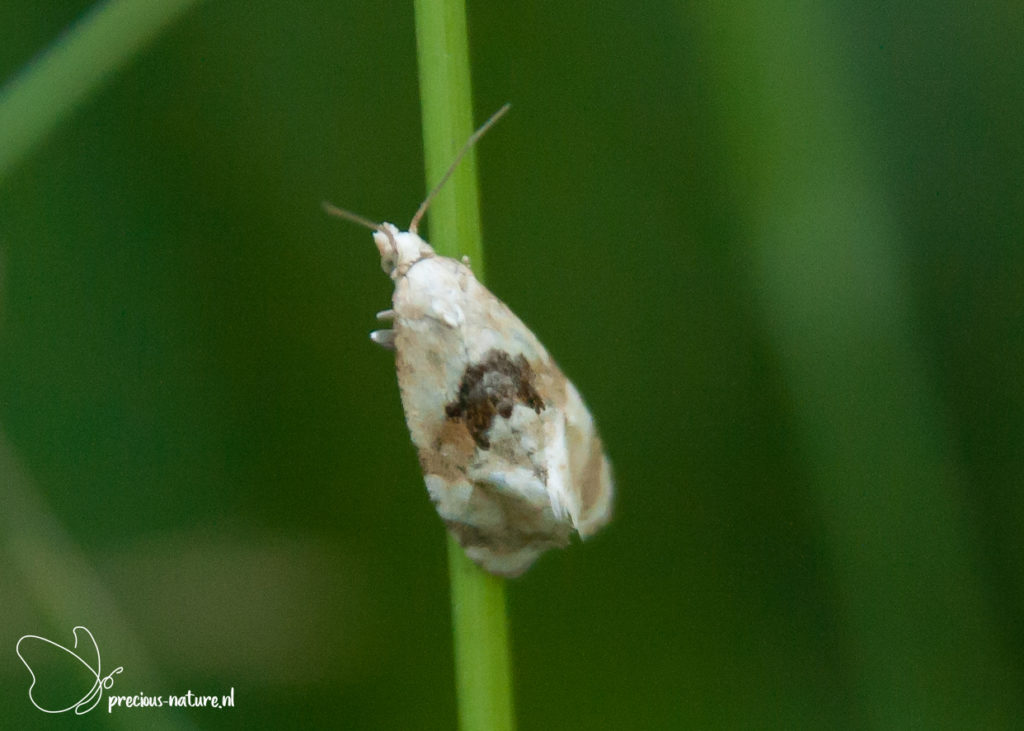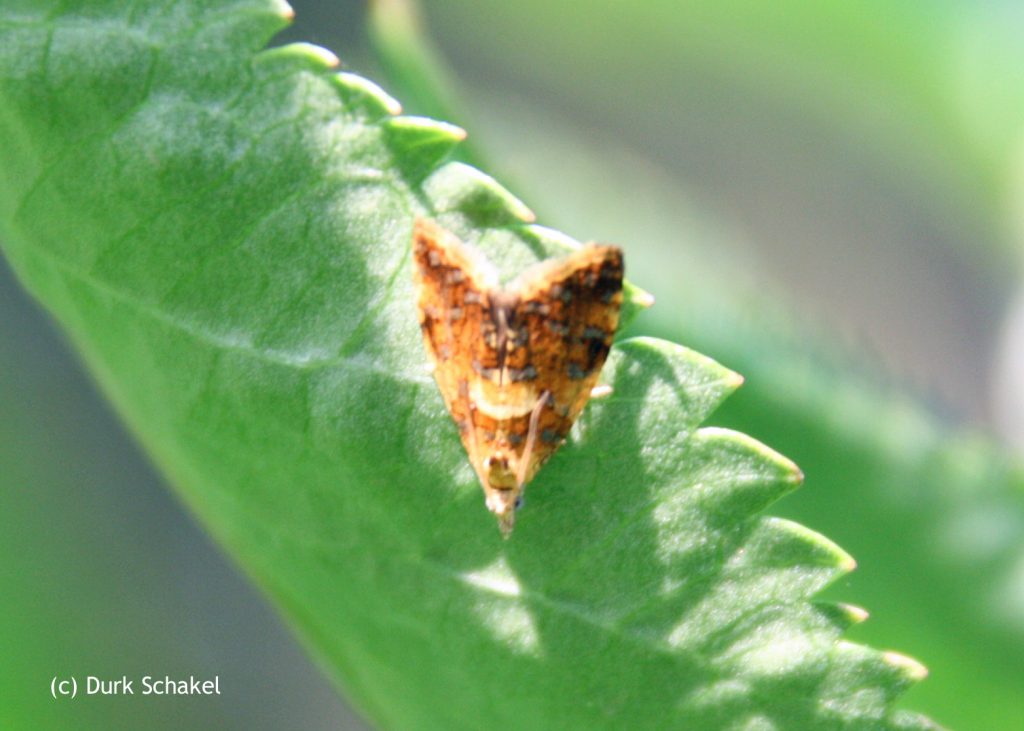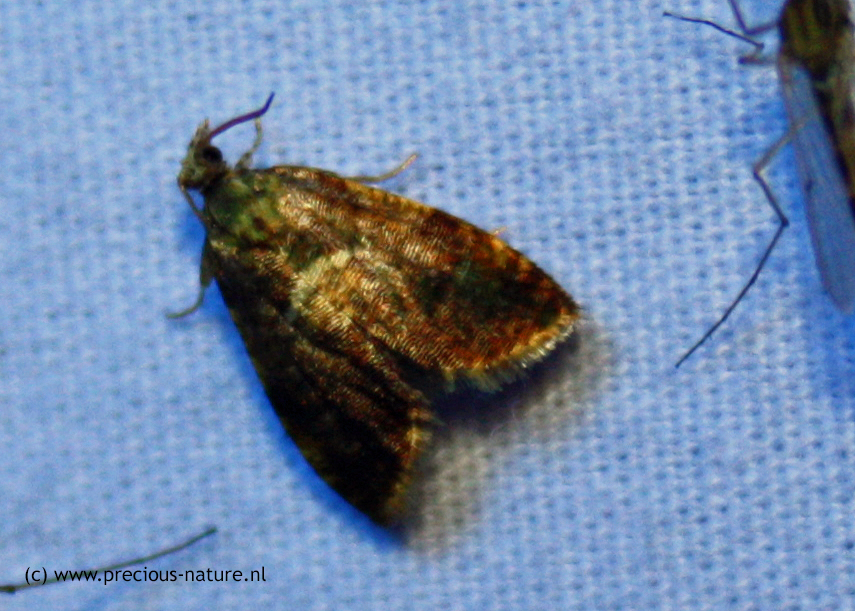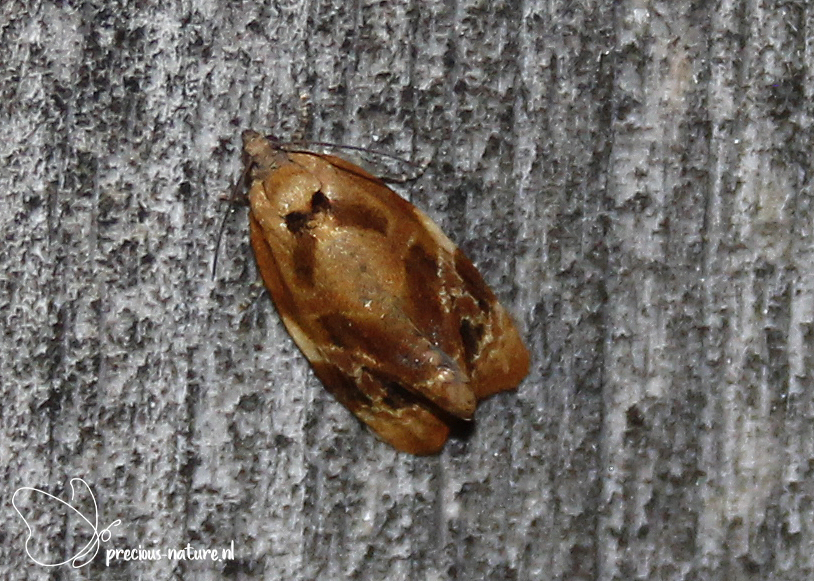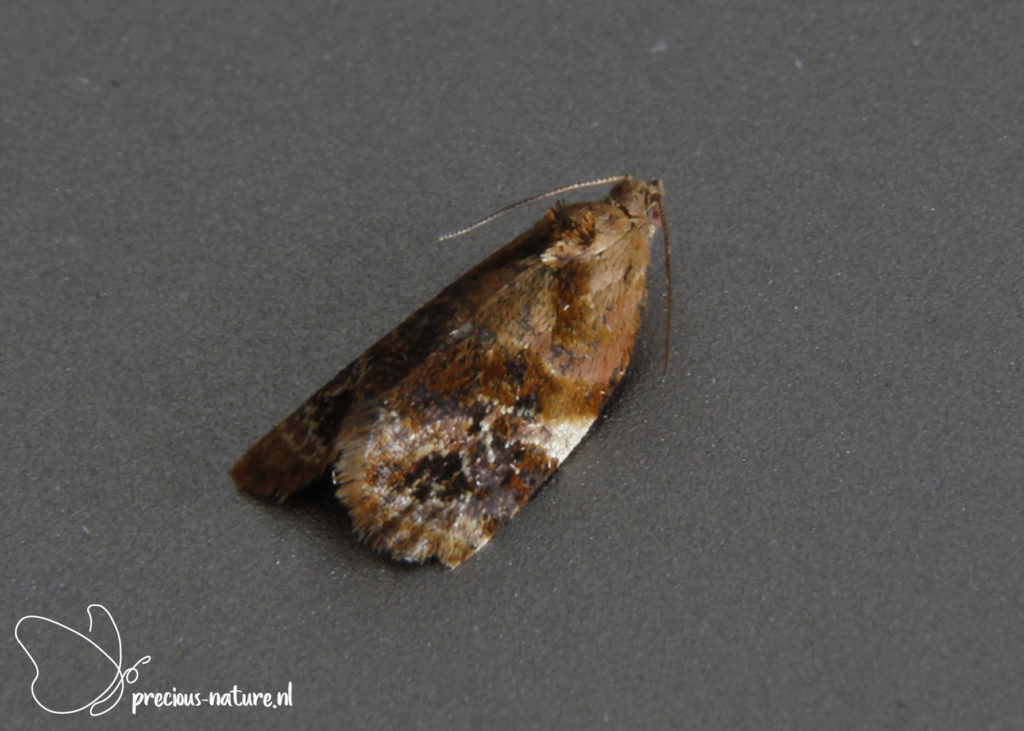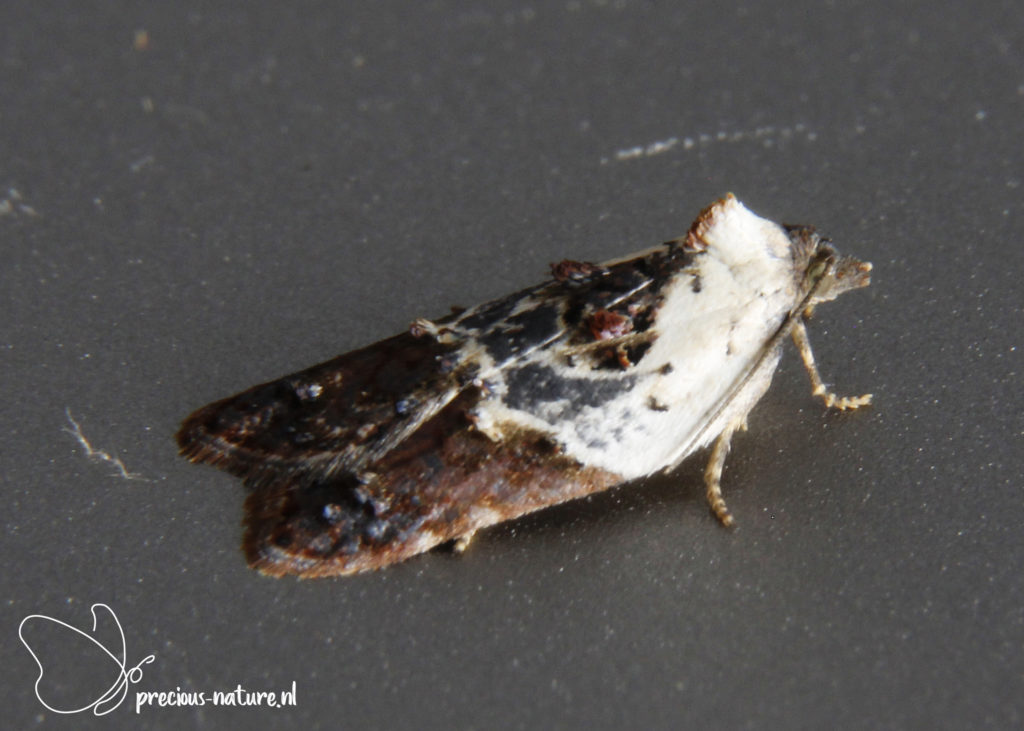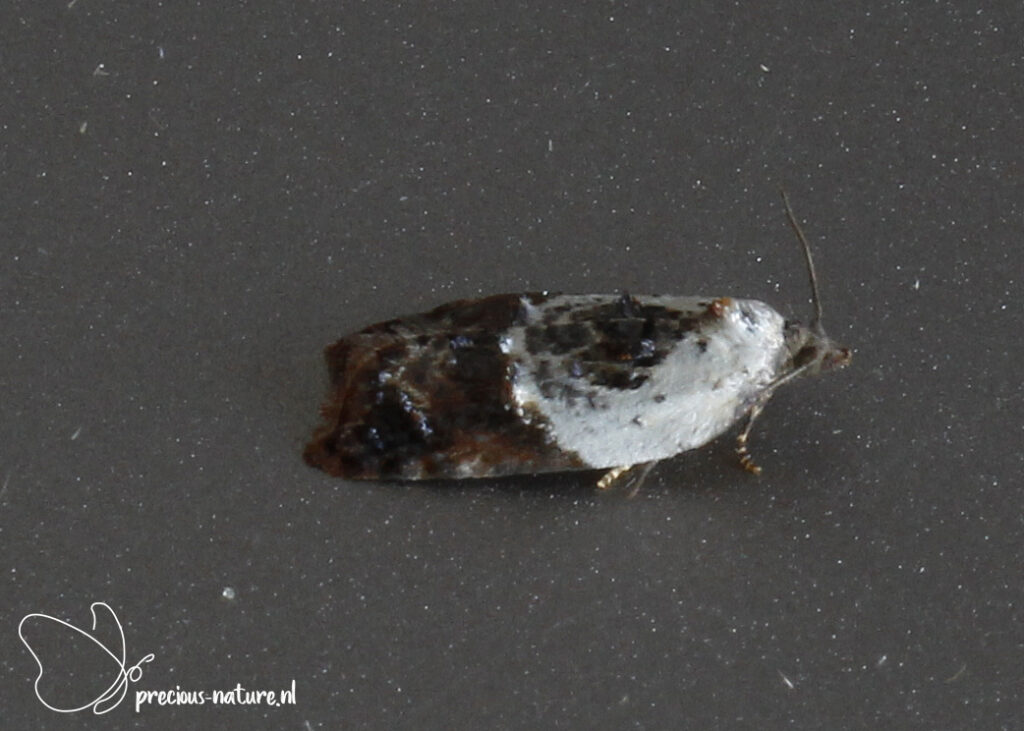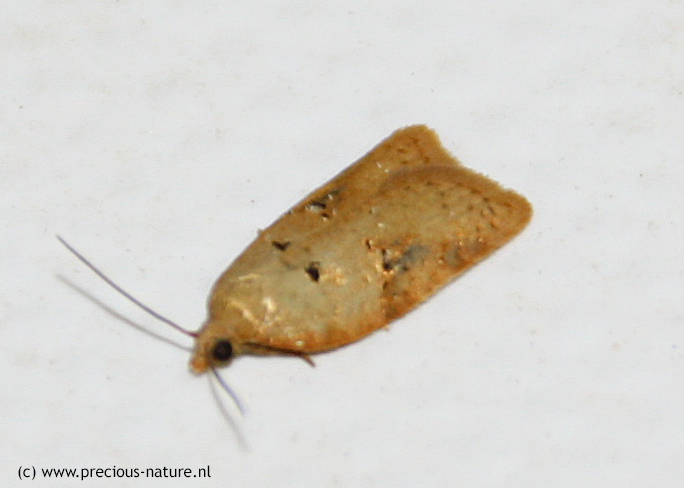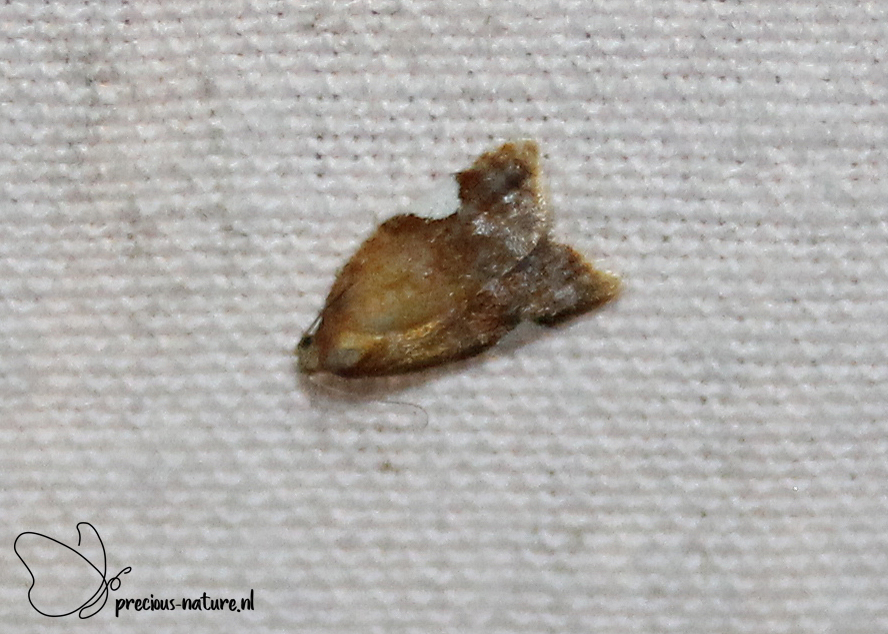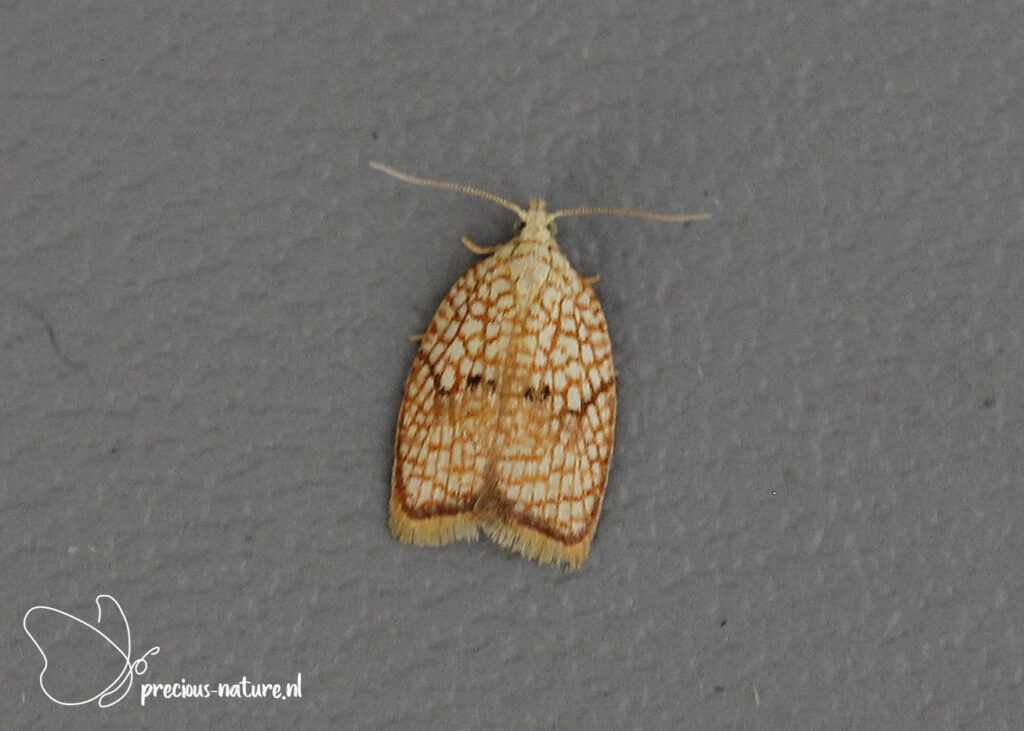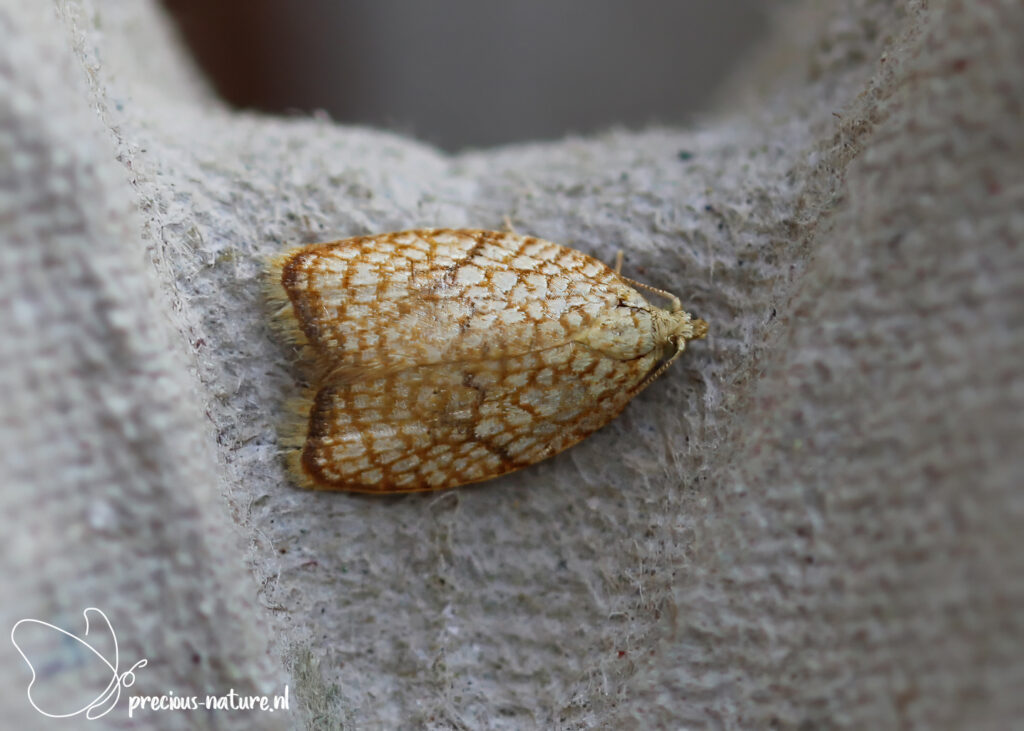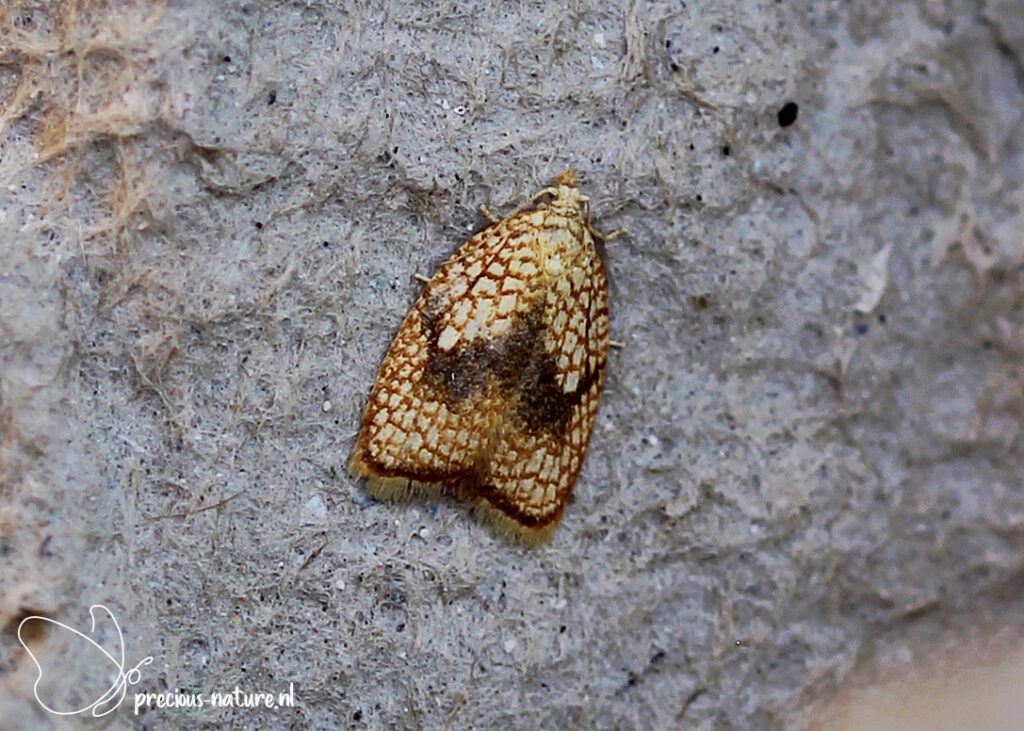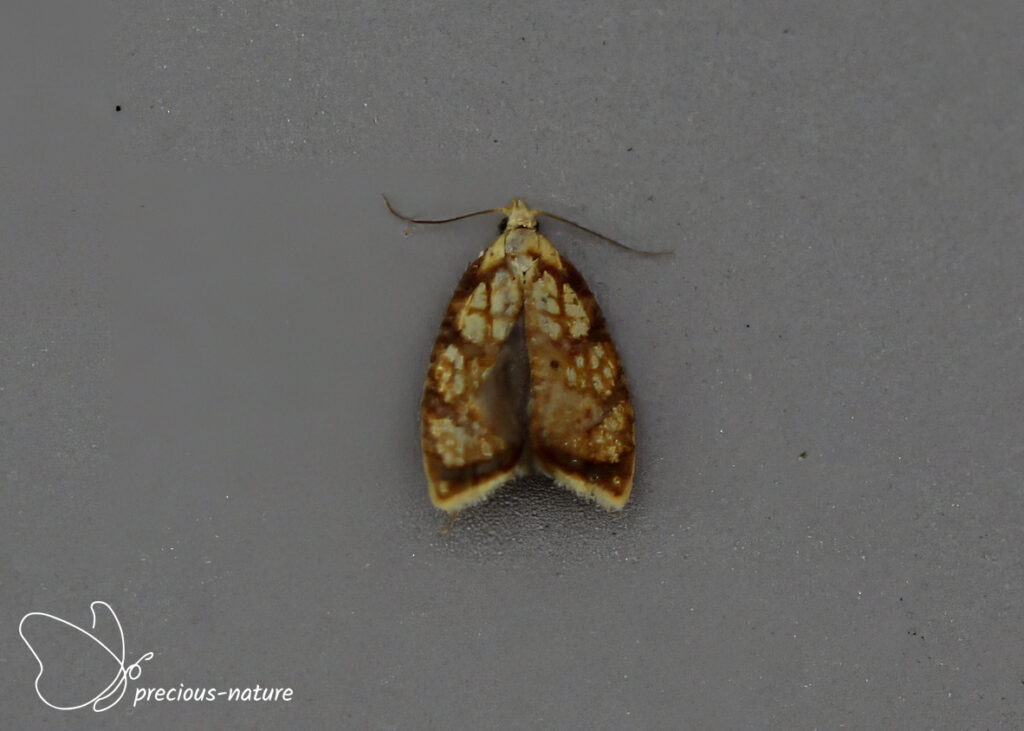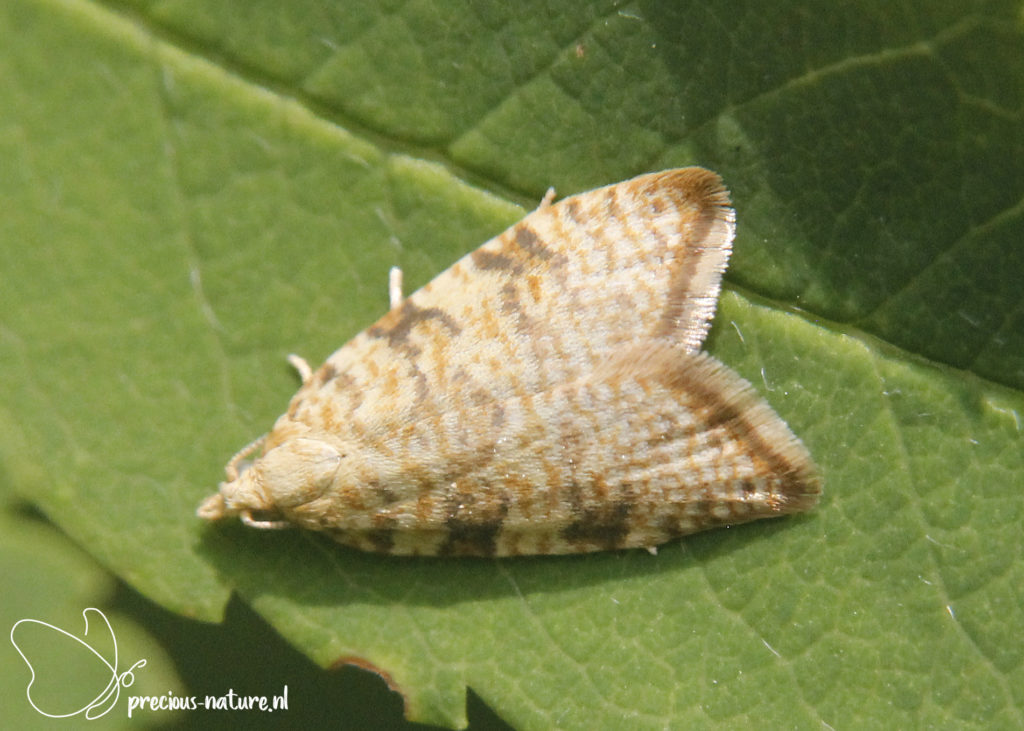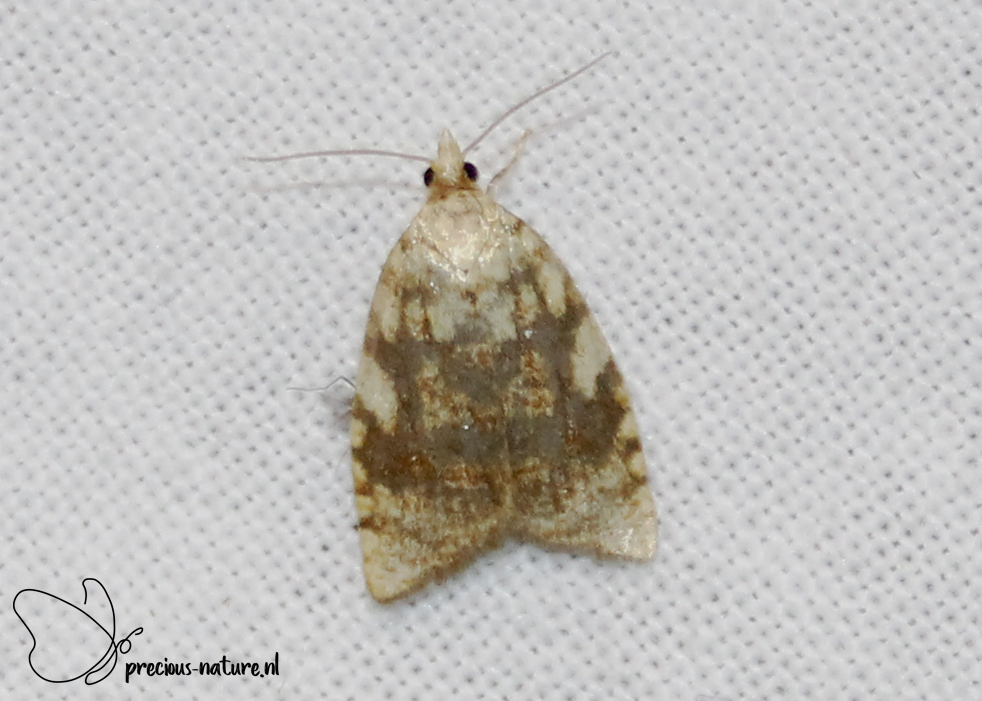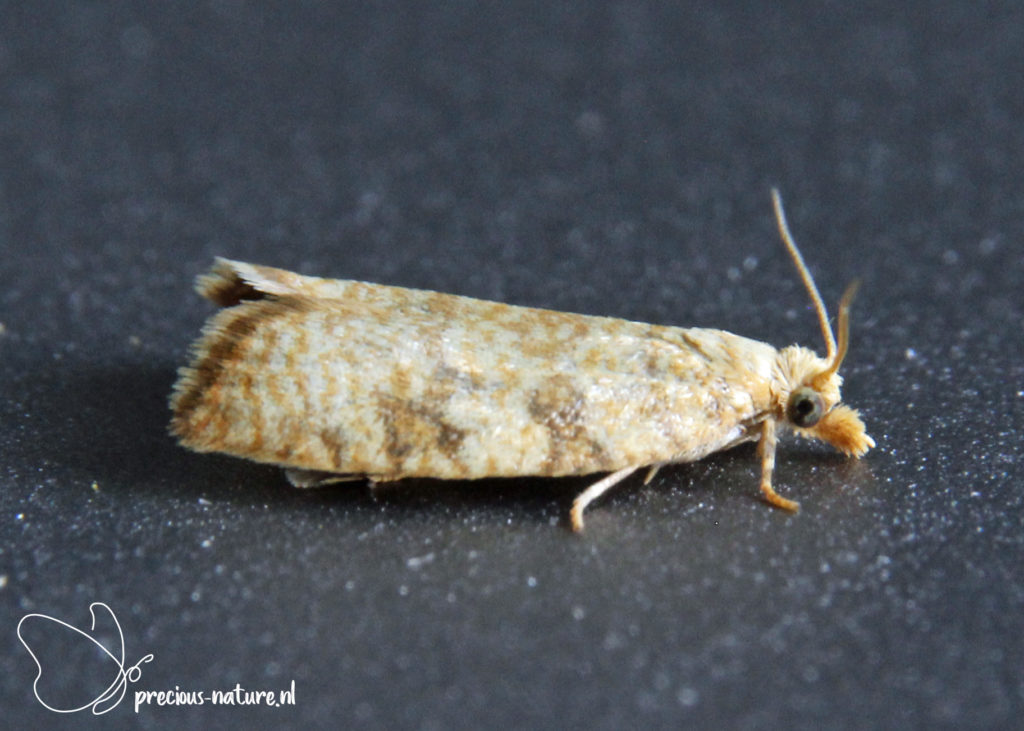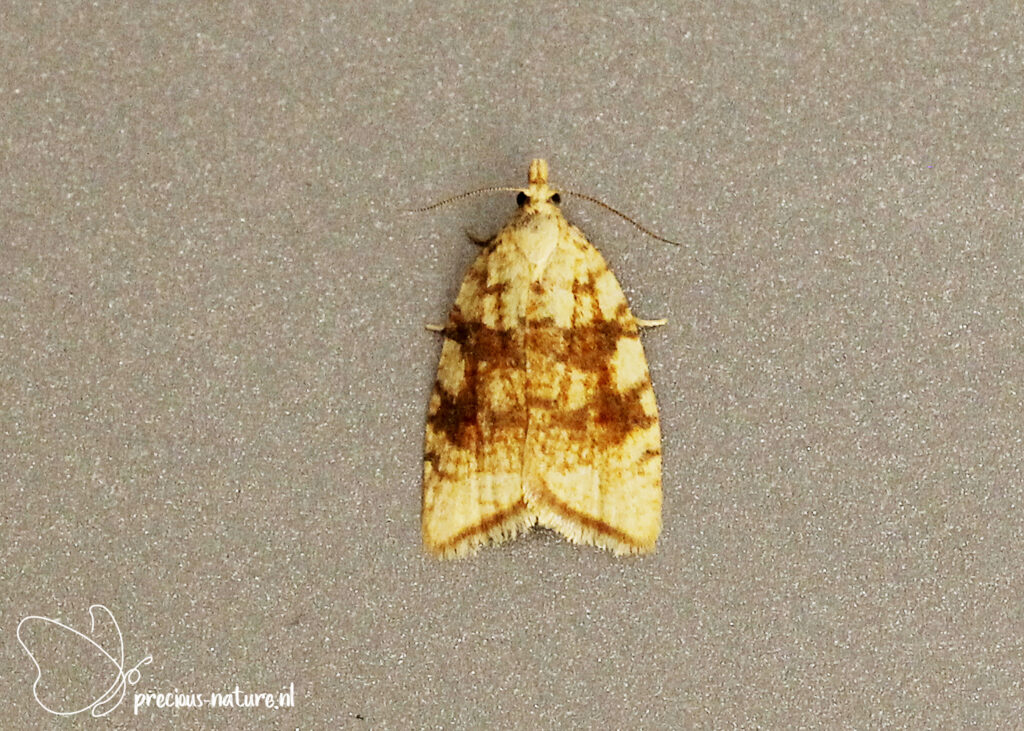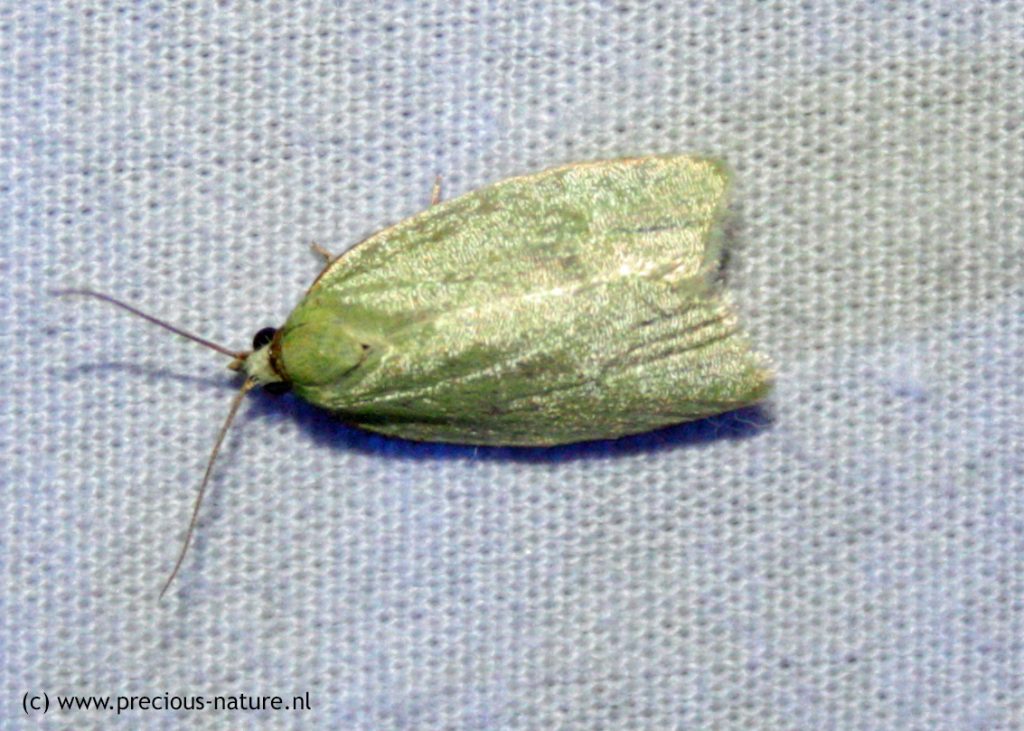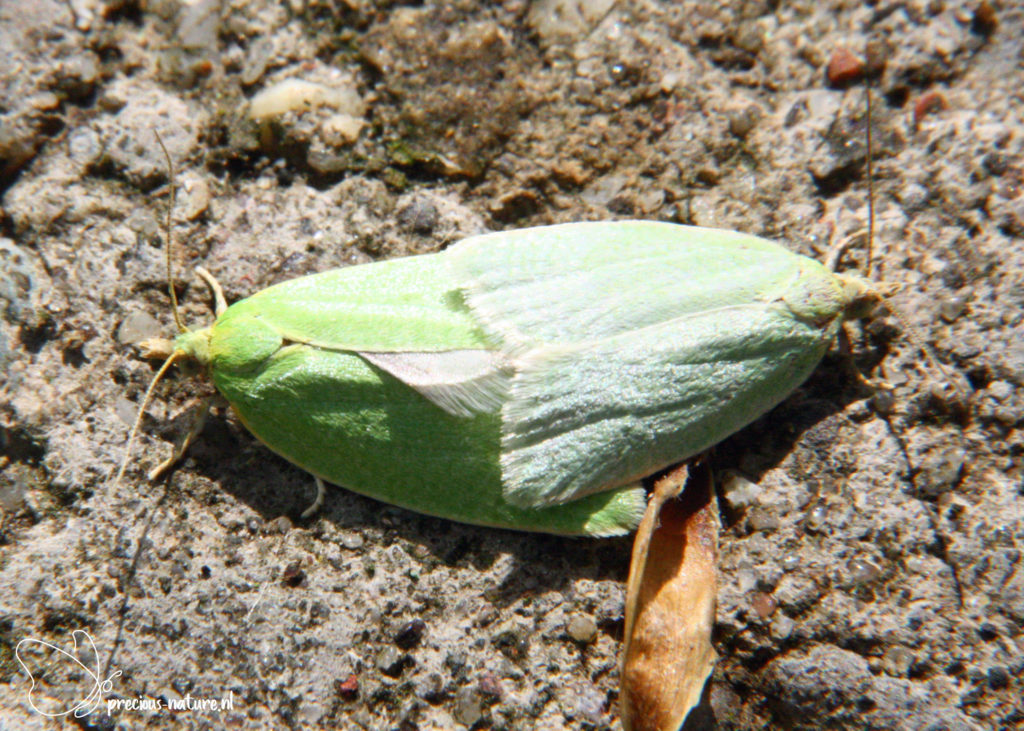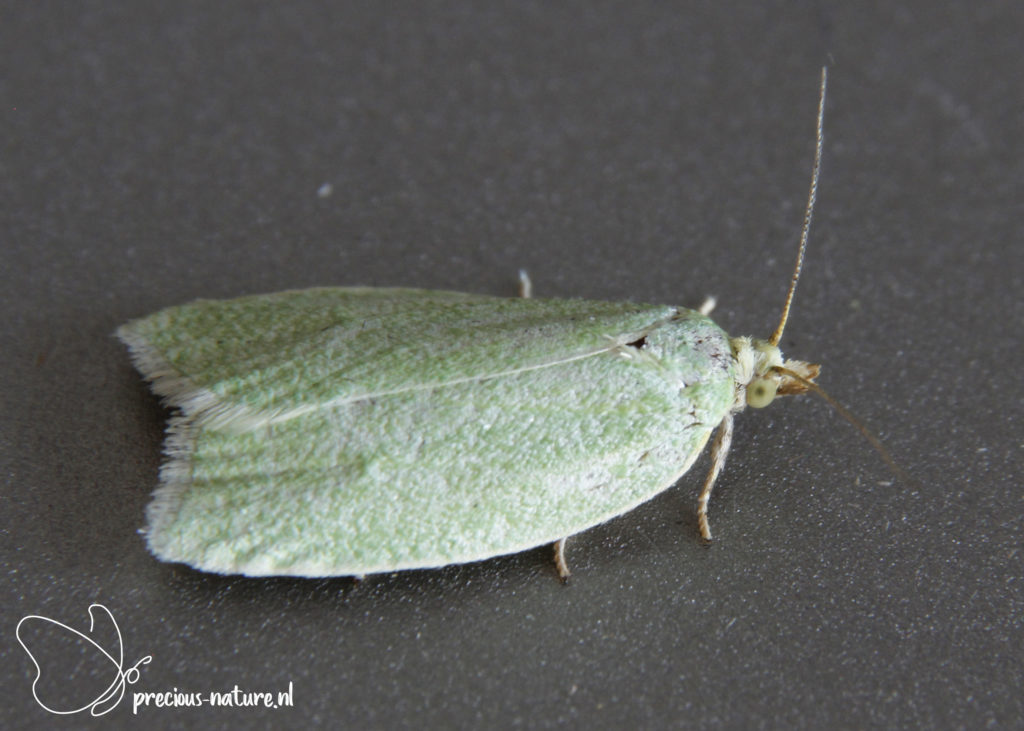The Tortricinae is a subfamily of the leafrollers (Tortricidae), of which about 4,200 species have been described worldwide. It is a monophyletic group, a group of organisms that are believed to have shared a common ancestor, which is itself included in the taxon, and all of whose descendants are placed in the same group. The Tortricinae is a sister group of the Olethreutinae. The primary food source is from 2 or more plant families with which they are polyphagous. The eggs are laid individually, in small groups, or in large masses. The hatched larvae are mainly leafrollers.
Tribe: Archipini
Genus: Adoxophyes
Summer Fruit Tortrix – 2023 (NL)
(NCBI-index: 480707)
The male of the Summer Fruit Tortrix (Adoxophyes orana) is usually smaller than the female. The forewing of the male is tan with dark brown markings. The wing root is dark coloured, and a brown spot can be seen along the leading edge near the wing tip. Starting at 1/3, a dark band runs from the leading edge towards the centre of the inner edge. The flight period spans two generations, from May to October, and the wingspan ranges from 15 to 22 mm. Host plant: Apple, Pear, Plum, Willow, Rose, Honeysuckle. Dutch name: Vruchtbladroller. Frisian name: –
Flying period:

Tribe: Archipini
Genus: Aphelia
Timothy Tortrix – 2021 (NL)
(NCBI-index: 753154)
A fairly easy-to-describe leaf roller is the Timothy Tortrix (Aphelia paleana). The forewing is white-grey to pale yellow-brown without further markings. In males, the base of the wing, thorax, and head is mainly orange-yellow. The underside of the forewing is pale grey-brown. The flight period spans one generation, from June to September, and the wingspan ranges from 18 to 22 mm. The larvae feed on a spun leaf. Host plant: Common Couch, Knapweed, Plantain, Meadowsweet. Dutch name: Gele bladroller. Frisian name: –
Flying period:

Tribe: Archipini
Genus: Archips
Large Fruit-tree Tortrix – 2017 (NL)
(NCBI-index: 2.655036)
The Large Fruit-tree Tortrix (Archips podana) is a fairly easy-to-recognise leafroller because of the “bell” shape, which can be seen when resting. The males and females are different in colour. The female is brown with only a dark, elongated spot along the costa. The male has a dark median band in the middle of the wing and a dark spot at the base. Furthermore, the male has a white zone on the wing. This leafroller flies in two generations from May to September, and the wingspan is 18-26mm. The larvae feed on various deciduous trees’ foliage, flowers, and fruit. Host plant: Hazel, Beech, Apple, Pear, Rose, Blueberry. Dutch name: Grote appelbladroller. Frisian name: –
Flying period:

Tribe: Archipini
Genus: Archips
Variegated Golden Tortrix – 2018 (NL)
(NCBI-index: 1.100919)
A leafroller that is certainly not the mother’s prettiest and took me a bit more time to identify is the Variegated Golden Tortrix (Archips xylosteana). The very dark, almost black specimens make identification very difficult. Typically, the forewings are pale yellow-brown, sometimes dark, and predominantly grey-brown with reddish-brown markings. The base field forms an oblique slender spot with a rounded top. The median band is very sloping, especially in males. The lower half is significantly widened, the costa slightly concave, and the dorsum clear everywhere with a crooked tooth above and an obtuse angle below the middle. The spot at the costa is wider and rectangular. The flying period spans from the end of May to mid-August in one generation, and the wingspan ranges from 15 to 23 mm. Larvae can be found in a rolled leaf. Host plant: Maple, Hawthorn, Poplar, Birch, Honeysuckle, fruit trees. Dutch name: Gevlamde bladroller. Frisian name: –
Flying period:

Tribe: Archipini
Genus: Archips
Pine Tortrix – 2018 (NL)
(NCBI-index: 1.100917)
As with several leafrollers of the Archips spp., the beautiful Pine Tortrix (Archips oporana) male is also smaller and more marked than the female. The male’s forewing is purplish-brown with reddish-brown markings surrounded by a thin white line. The females have a pale purplish-brown with reddish-brown markings and a net-like pattern all over the wing. The hindwing is grey-brown with a coppery glow in the male, while it is more orange in the female. The flying period is from June to July in one generation, and the wingspan is 19-28mm. The larvae feed amongst the needles. Host plant: Scots Pine, Silver Fir. Dutch name: Fraaie dennenbladroller. Frisian name: –
Flying period:

Tribe: Archipini
Genus: Archips
Brown Oak Tortrix – 2021 (NL)
(NCBI-index: 1.857967)
The ground colour of the male Brown Oak Tortrix (Archips crataegana) is usually lighter than that of the female. Dark brown markings can be seen on the light grey-brown wing. From the base of the wing, a short bar runs obliquely from the dorsum to the centre of the wing. On 2/3, a large stain can be seen that does not extend to the costa. Near the apex, a stain runs obliquely from the costa to the dorsum. All spots are lightly outlined, and the apex is pointed. The flight period is from June to September in one generation, and the wingspan is 19-22 mm for the male and 23-28 mm for the female. The larvae roll in the leaves of the host plant. Host plant: Oak, Ash, Elm, Sallow. Dutch name: Meidoornbladroller. Frisian name: –
Flying period:

Tribe: Archipini
Genus: Caoecimorpha
Carnation Tortrix – 2018 (NL)
(NCBI-index: 287198)
The male Carnation Tortrix (Caoecimorpha pronuba) is distinguishable from the female. The male is smaller than the female. The male’s forewing is dark yellow-brown with a faint, dark brown, net-like pattern on the outside, and a dark brown to purplish spot. The female’s wings are more extended, and a peak shape can be seen at the apex. The top of the wing is lighter in colour, and the reticulated pattern is visible. The hindwing is orangish. The flying period is two generations for much of the year, and the wingspan is 14-24 mm. Larvae can be found in the spinning. Host plant: Rose, Spurge, Cardinal’s Cap. Dutch name: Anjerbladroller. Frisian name: –
Flying period:

Tribe: Archipini
Genus: Choristoneura
Great Tortrix – 2023 (NL)
(NCBI-index: 1.100946)
One of the larger species and easily recognisable is the Great Tortrix (Choristaneura hebenstreitella). The forewing is tan, grey, and tinged with faint brown lines, creating a net structure. Halfway along the inner edge, a broad, dark transverse band falls short of the dark spot at the leading edge. Near the wing tip, a second dark spot, almost a semicircle, can be seen along the leading edge. A dark zone is also present at the wing root, distinguishing it from the Large Ivy Tortrix (Lozotaenia forsterana). The flight period spans one generation, from late May to July, and the wingspan ranges from 20 to 30 mm. Host plant: Oak, Birch, Hazel. Dutch name: Reuzenbladroller. Frisian name: –
Flying period:

Tribe: Archipini
Genus: Clepsis
Cyclamen Tortrix – 2018 (NL)
(NCBI-index: 1.144650)
A common leafroller is the Cyclamen Tortrix (Clepsis spectrana). The forewing is pale yellow-brown, sometimes a little reddish, with various speckles. The dark brown transverse band halfway down the wing and the dark brown spot near the apex are striking. The flying period spans two generations, from May to September, and the wingspan ranges from 16 to 22 mm. The larvae feed on the spun leaves and flowers. Host plant: Willow, Meadowsweet, Yellow Flag, Nettle, Honeysuckle, Cyclamen, Strawberry, Hop. Dutch name: Koolbladroller. Frisian name: –
Flying period:

Tribe: Archipini
Genus: Clepsis
Privet Tortrix – 2018 (NL)
(NCBI-index: 1.100947)
The male and female of the Privet Tortrix (Clepsis consimilana) are, as you often see with the leafrollers, differently marked. The male’s forewing is tan with light markings and an oblique transverse band. The female is darker and has a reddish-brown speckle on the forewing. Furthermore, the female has no transverse band or other markings except for a few black spots along the termen. The flying period in one generation is from June to September, and the wingspan is 13-19 mm. The larvae feed on trees, preferring dead or withered leaves in a dense, untidy spinning. Host plant: Privet, Lilac, Honeysuckle, Hawthorn, Apple. Dutch name: Tuinbladroller. Frisian name: –
Flying period:

Tribe: Archipini
Genus: Clepsis
Wood-rush Tortrix – 2024 (CH)
(NCBI-index: 1.197227)
Sometimes you discover a species for which there is a Latin name, but no Dutch or English name. For leafrollers, you often see that the name is related to the host plant. That is why I have chosen the Wood-rush Tortrix (Clepsis rogana). In most cases, the upper side of the forewing with its pale white base colour is a variation of yellow spots with brownish scales in between. The fringes are white. The flight period is one generation from June to August, and the wingspan is 20-22 mm. Host plant: Wood-rush, Bilberry, White Hellebore. Dutch name: Veldbesbladroller. Frisian name: –
Flying period:

Tribe: Archipini
Genus: Lozotaeniodes
Orange Pine Tortrix – 2020 (NL)
(NCBI-index: 1.870046)
The forewing of the Orange Pine Tortrix (Lozotaeniodes formosana) is pale yellow-brown with many lighter, continuous spots that are dark reddish-brown edged. The flying period in one generation is from May to August, and sometimes a second generation in October. The wingspan is 20-26 mm, and the larvae feed in a silk tube along a twig. Host plant: Scots Pine. Dutch name: Stipjesbladroller. Frisian name: –
Flying period:

Tribe: Archipini
Genus: Pandemis
Barred Fruit-tree Tortrix – 2017 (NL)
(NCBI-index: 572788)
The Barred Fruit-tree Tortrix (Pandemis cerasana) is a small leafroller that, like many relatives, keeps its wings in a flat “bell” shape when resting. The top of the wing is brown, and from above, a clear brown V-shaped band can be seen. More to the apex, a dark brown spot can be seen along the termen. Flight time is one generation from June to September, and the wingspan is 16-25 mm. Larvae can be found in a rolled or folded leaf. Host plant: Oak, Alder, Birch, Bilberry. Dutch name: Kersenbladroller. Frisian name: –
Flying period:

Tribe: Archipini
Genus: Ptycholoma
Brindled Tortrix – 2020 (NL)
(NCBI-index: 116133)
The forewing of the Brindled Tortrix (Ptycholoma lecheana) is predominantly yellow-brown with many dark to pale ruddy brown spots in the outer half. A dark oblique spot is visible halfway along the dorsum. Furthermore, a lead-grey thin cross band halfway down the wing from the costa and a second lead-grey cross band more towards the apex. The flying period in one generation is from May to mid-August, and the wingspan is 16-20 mm. The larvae feed on rolled or spun leaves. Host plant: Apple, Poplar, Oak, Willow, Larch. Dutch name: Geelbuikbladroller. Frisian name: –
Flying period:

Tribe: Archipini
Genus: Syndemis
Dark-barred Tortrix – 2020 (NL)
(NCBI-index: 1.101060)
The forewing of the Dark-barred Tortrix (Syndemis musculana) is grey-white, silver-grey to grey-brown, and sparsely speckled. From the centre of the dorsum, a dark brown, sometimes black, median band tapers towards the costa. A dark spot can be seen along the costa close to the apex. The intensity of the markers varies widely. The flying period in one generation is from the end of April to the middle of July, and the wingspan is 15-22 mm. The larvae feed on a rolled or folded leaf. Host plant: Bog-myrtle, Bramble, Oak, Birch. Dutch name: Struikbladroller. Frisian name: –
Flying period:

Tribe: Cochylini
Genus: Aethes
Burdock Conch – 2020 (NL)
(NCBI-index: 1.594218)
The Burdock Conch (Aethes rubigana) is very similar to the Thistle Conch (Aethes cnicana). The big difference is in the dark cross band on the cream-white forewing, which is wider in the Burdock Conch than in the Thistle Conch. Light brown patches can also be seen on the forewing, with the two spots close to the costa being slightly darker. The flying period in one generation is from the beginning of June to August, and the wingspan is 15-19 mm. The larvae feed on seeds. Host plant: Greater Burdock. Dutch name: Donker c-smaluiltje. Frisian name: –
Flying period:

Tribe: Cochylini
Genus: Aethes
Yarrow Conch – 2020 (NL)
(NCBI-index: 1.594220)
The Yarrow Conch (Aethes smeathmanniana) has a pale yellow forewing with some yellow-brown spots. Furthermore, two orange-brown or red-brown transverse bands run from the dorsum to the centre. The cross band on 1/3 continues to the centre, and the cross band on 2/3 is relatively short. The flying period in one generation is from the beginning of May to the middle of June, and the wingspan is 12-19 mm. The larvae feed on the seeds from the yarrow I have as a host plant in my garden. Host plant: Yarrow, Common Knapweed, Corn Chamomile. Dutch name: Kommabladroller. Frisian name: –
Flying period:

Tribe: Cochylini
Genus: Agapeta
Common Yellow Conch – 2017 (NL)
(NCBI-index: 1.100904)
The Common Yellow Conch (Agapeta hamana) has a bright, pale yellow forewing. On the forewing, there are different numbers of orange or brown markings that differ in intensity. In any case, there is always a clear, broad line from the centre to the tornus of the forewing. It flies in the evening and comes on light easily. The flying period is from April to September, possibly in one generation, and the wingspan is 15-24 mm. The larvae can be found in the roots. Host plant: Musk, Thistle. Dutch name: Distelbladroller. Frisian name: –
Flying period:

Tribe: Cochylini
Genus: Cochylimorpha
Straw Conch – 2022 (NL)
(NCBI-index: 1.660606)
Discovering new leaf rollers in the moth trap is always a surprise. Since many leaf rollers look alike at first glance, I remain alert to possible new species. The Straw Conch (Cochylimorpha straminea) is a leaf roller of a similar species. It is a reasonably solid buff moth with a pale rust-coloured band forming a ‘V’ pattern on its back. Some dark brown spots are along the leading edge near the wing tip. Some brown spots are near the trailing edge, but none of the markings are particularly pronounced. The flight period spans two generations, from May to September, and the wingspan ranges from 10 to 16 mm. The larvae feed in the stem just below the flower bud or in young shoots as far as the second generation is concerned. Host plant: Common Knotweed. Dutch name: Moerasbladroller. Frisian name: –
Flying period:

Tribe: Cochylini
Genus: Cochylis
Birch Conch – 2021 (NL)
(NCBI-index: 1.594254)
The Birch Conch (Cochylis nana) has a white head and a white forewing with heavily suffused pale yellow-brown areas. The basal area of the wing is grey, extending along the costa. Halfway from the dorsum, a grey mixed black cross-band narrows towards the costa. A yellow-brown spot can be seen in the centre of this cross-band. The flight period is from May to July in one generation, and the wingspan is 9-13 mm. Host plant: Birch. Dutch name: Vroege dwergbladroller. Frisian name: –
Flying period:

Tribe: Cochylini
Genus: Eulia
Brassy Tortrix – 2019 (NL)
(NCBI-index: 572847)
A leafroller that derives its name from the colour scheme is the Brassy Tortrix (Eulia ministrana). The forewing is pale yellow with orange-brown to reddish-brown spots in the centre and towards the costal edge. There is a white dot or spot at 3/4. The flying period is from April to July in one generation, and the wingspan is 18-25mm. The larvae feed in the spinning between two leaves. Host plant: Birch, Oak, Willow. Dutch name: Papegaaibladroller. Frisian name: –
Flying period:

Tribe: Cochylini
Genus: Gynnidomorpha
Coast Conch – 2019 (NL)
(NCBI-index: 1.176455)
Leafrollers can be pretty challenging to identify, especially when species from a subfamily are very similar. For now, I will stick to a Coast Conch (Gynnidomorpha permixtana), but this micro moth can also be confused with the somewhat larger Fen Conch (Gynnidomorpha minimana). The Coast Conch has a cream-orange-brown forewing with dark brown or grey spots here and there, especially along the costa. There is an oblique dark cross band from 1/3 of the dorsal edge to near the costal edge, where it bends to halfway up the costal edge. The flying period spans two generations, from May to June and from the end of July to August, and the wingspan is 10-12 mm. Larvae could be found in the flowers and the seeds. Host plant: Red Bartsia. Dutch name: Ratelaarbladroller. Frisian name: –
Flying period:

Tribe: Cochylini
Genus: Neocochylis
White-faced Straw – 2024 (CH)
(NCBI-index: 2.769475)
The White-faced Straw (Neocochylis dubitana) has, like the White-fronted Straw (Neocochylis hybridella), been transferred from the genus Cochylis to the genus Neocochylis. Both leafrollers look very similar, but a third similar leafroller, the Black-fronted Straw (Cochylis atricapitana), has not changed its genus name. The forewing is predominantly white with yellowish irregular spots. The wing root is grey-speckled black, just like the wing tip. A mark of the same colour can be seen along the trailing edge. Head, palps and thorax colours can distinguish the three leafrollers. The White-faced Straw has a white head and palps and a black thorax; in the White-fronted Straw, all these parts are white, and in the Black-fronted Straw, they are black. The flight period spans two generations, from May to September, and the wingspan ranges from 12 to 14 mm. Host plant: Ragwort, Hawkbeards, Perennial Sow-thistle. Dutch name: Blauwe distelbladroller. Frisian name: –
Flying period:
![]()
Tribe: Cochylini
Genus: Phalonidia
Loosestrife Conch – 2019 (NL)
(NCBI-index: 1.176460)
The Loosestrife Conch (Phalonidia udana) is difficult to identify. This leafroller is often confused with the Water-mint Conch (Phalonidia manniana). A genital examination is necessary to provide certainty. Based on the colours of the species that I have spotted, I think I am dealing with the Loosestrife Conch. On the predominantly light brown-white forewing, a light brown transverse band starts halfway from the costa, which kinks after 1/3 and turns into a dark brown band. Near the apex is a light brown transverse band that runs diagonally toward the dorsum. The Water-mint Conch often gives a darker and more colourful impression. The flying period is from April to August, and the wingspan is 10-14 mm. Host plant: Reed. Dutch name: Wederikbladroller. Frisian name: –
Flying period:

Tribe: Cochylini
Genus: Pseudoargyrotoza
Yellow-spot Twist – 2017 (NL)
(NCBI-index: 1.101037)
The Yellow-spot Twist (Pseudargyrotoza conwagana) is a small yellow-brown leafroller with a striking light yellow spot visible when resting. Furthermore, the small silver-grey spots that form the transverse lines stand out. The flight time is from May to July and can be admired during the day. The wingspan is 11-15 mm. Larvae feed on seeds or berries. Host plant: Privet, Ash. Dutch name: Zilvervlekbladroller. Frisian name: –
Flying period:

Tribe: Ramapesiini
Genus: Ditula
Red-barred Tortrix – 2018 (NL)
(NCBI-index: 572840)
The Red-barred Tortrix (Ditula angustiorana) is a relatively small micro-moth. The females are often slightly larger, and the markings are somewhat different. The male’s forewing is brown with a pale yellowish-brown circular spot halfway down the wing along the inner margin. Furthermore, a narrow reddish-brown cross band and a reddish-brown marking along the costa near the apex can be seen halfway down the wing. The female’s wing is more orange-brown with a small yellow-brown spot along the costa halfway down. The flying period spans from May to August in one generation, and the wingspan ranges from 12 to 18 mm. Larvae usually can be found among spun leaves and developing fruit buds. Host plant: Apple, Pear, Ivy, Juniper, Larch. Dutch name: Zomerbladroller. Frisian name: –
Flying period:

Tribe: Tortricini
Genus: Acleris
Garden Rose Tortrix – 2018 (NL)
(NCBI-index: 572803)
The Garden Rose Tortrix (Acleris variegana) is an easily recognised micro-moth. A clear white spot can be seen when resting with a dark round spot in the middle. The rest of the wing is dark brown or grey. Flight time is one generation from July to September, and the wingspan is 14-18 mm. Larvae can be found in a folded leaf or loosely spun leaves. Host plant: Hawthorn, Blackthorn, Pear, Rose, Hazel, Elm. Dutch name: Witschouderbladroller. Frisian name: –
Flying period:

Tribe: Tortricini
Genus: Acleris
Rusty Oak Button – 2018 (FR)
(NCBI-index: 758707)
The Rusty Oak Button (Acleris ferrugana) is almost indistinguishable from the Rusty Birch Button (Acleris notana). It would be best to do this through genital testing. I am, therefore, not entirely sure whether I made the right choice. The forewing is tan to dark reddish-brown with variable black spots. At the costa is a triangle-shaped pale brown band with the tip protruding halfway up the wing. This dark band is completely smooth with the Rusty Birch Button, while the Rusty Oak Button has a notch on both sides of the triangle. Near the wingtip, it is black with some silver-grey spots. A straightforward black point can be seen at 1/3 from the base. The flying period spans two generations: one from July to mid-August and another from September to May, during which the adults overwinter. The wingspan is 14-18 mm. The larvae feed mainly by spinning between leaves. Host plant: Oak. Dutch name: Lichte boogbladroller. Frisian name: –
Flying period:

Tribe: Tortricini
Genus: Acleris
Golden Leafroller Moth – 2020 (NL)
(NCBI-index: 572802)
One of the Acleris species that is relatively easy to recognise is the Golden Leafroller Moth (Acleris holmiana). The forewing is yellowish-brown with a lighter colour at the base and the apex. Especially the white triangular spot halfway down the costa makes it unique to recognise this species. The flying period is from June to the beginning of September, and the wingspan is 10-15 mm. The larvae feed between two spun leaves. Host plant: Hawthorn, Apple, Pear, Rose. Dutch name: Rode driehoekbladroller. Frisian name: –
Flying period:

Tribe: Tortricini
Genus: Acleris
Maple Button – 2023 (NL)
(NCBI-index: 572801)
A leafroller that is relatively easy to recognise because of its colour and pattern of brown lines is the Maple Button (Acleris forsskaleana). The forewing is yellow with a network of reddish-brown lines. Halfway down the forewing is a striking dark grey-brown line across the wing. Angled in the middle, this transverse line can vary considerably in intensity and width, sometimes with a dark grey spot in the middle. A broader dark grey-brown line runs along the rear edge. The flight period spans one generation, from June to mid-September, and the wingspan ranges from 12 to 17 mm. Host plant: Field Maple. Dutch name: Kleine boogbladroller. Frisian name: –
Flying period:

Tribe: Tortricini
Genus: Acleris
Yellow Rose Tortrix – 2025 (NL)
(NCBI-index: 763074)
A species that is easy to recognise and is common in gardens and hedges is the Yellow Rose Tortrix (Acleris bergmanniana). The head and body are yellow, as is the base colour of the forewing. The forewing is speckled orange, especially in the outer 2/3, with blue-grey markings that are bordered with dark brown. These markings, which run inward as transverse bands on 1/3 and just past the halfway point from the leading edge to halfway along the wing, are very prominent along the leading edge and trailing edge. It does sometimes happen that the blue-grey colour is missing, but the markings remain the same in structure. The flight period is one generation from June to early August, and the wingspan is 10-14 mm. The larvae grow in spun leaves and shoots. Host plant: Rose. Dutch name: Gouden boogbladroller. Frisian name: –
Flying period:

Tribe: Tortricini
Genus: Aleimma
Yellow Oak Button – 2019 (NL)
(NCBI-index: 758720)
On a summer evening, I came across the Yellow Oak Button (Aleimma loeflingiana) along a sidewalk among some weeds. Enjoying the last rays of the sun falling on its yellow-brown front wing, many small dark brown spots can be seen as if they were sun freckles. The variation in the drawing is substantial. Usually, there is a dark marking at the costa at 1/3 and halfway up, and the fringes have a comprehensive brown baseline. The flying period in one generation is from June to August, and the wingspan is 14-19mm. Larvae can be found in a rolled leaf or a pocket formed from a rolled leaf. Host plant: Oak, Maple. Dutch name: Zonnesproetbladroller. Frisian name: –
Flying period:

Tribe: Tortricini
Genus: Tortrix
Green Oak Tortrix – 2018 (NL)
(NCBI-index: 311328)
The Green Oak Tortrix (Tortrix viridana) is sometimes confused with the Cream-bordered Green Pea (Earias clorana). There is a clear difference. This micro-moth has its wings flat in the resting position, while the Cream-bordered Green Pea has them in a roof shape in the resting position. The forewing is light green with a light white spotty appearance. The costa shows a fragile yellow line. The males are slightly smaller than the females. The flying period is from May to July in one generation, and the wingspan is 18-23 mm. Larvae can be found in a rolled or folded leaf. Host plant: Oak. Dutch name: Groene eikenbladroller. Frisian name: –
Flying period:


